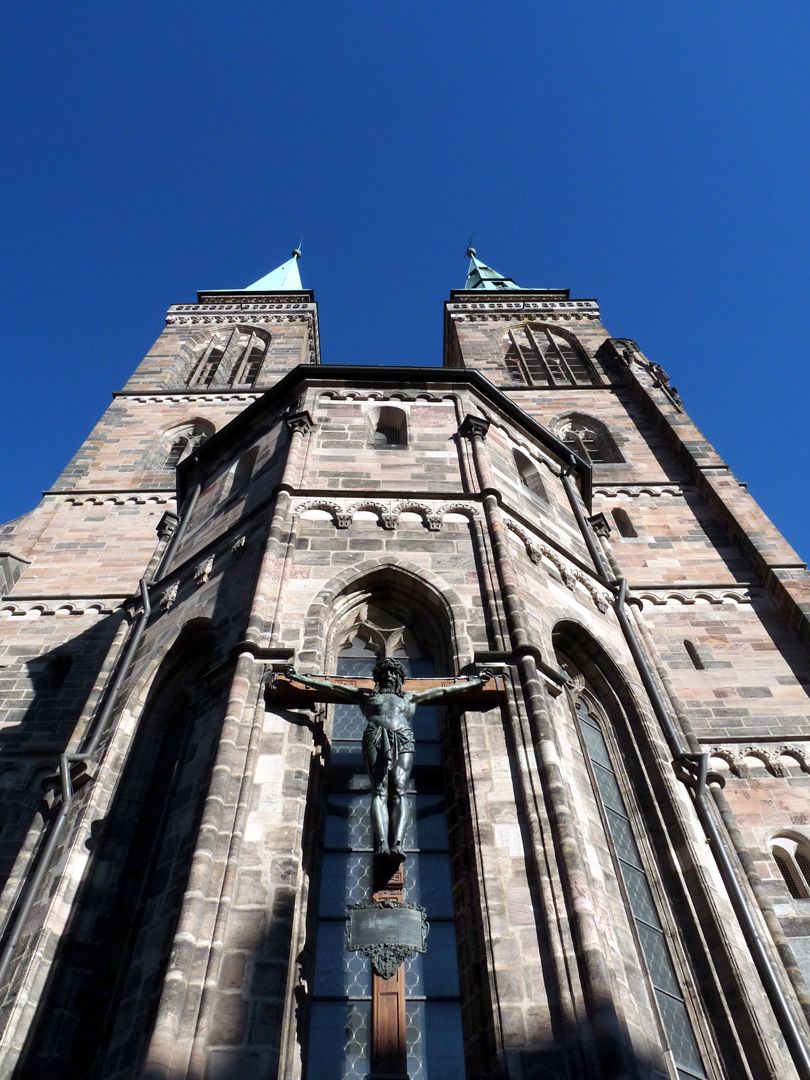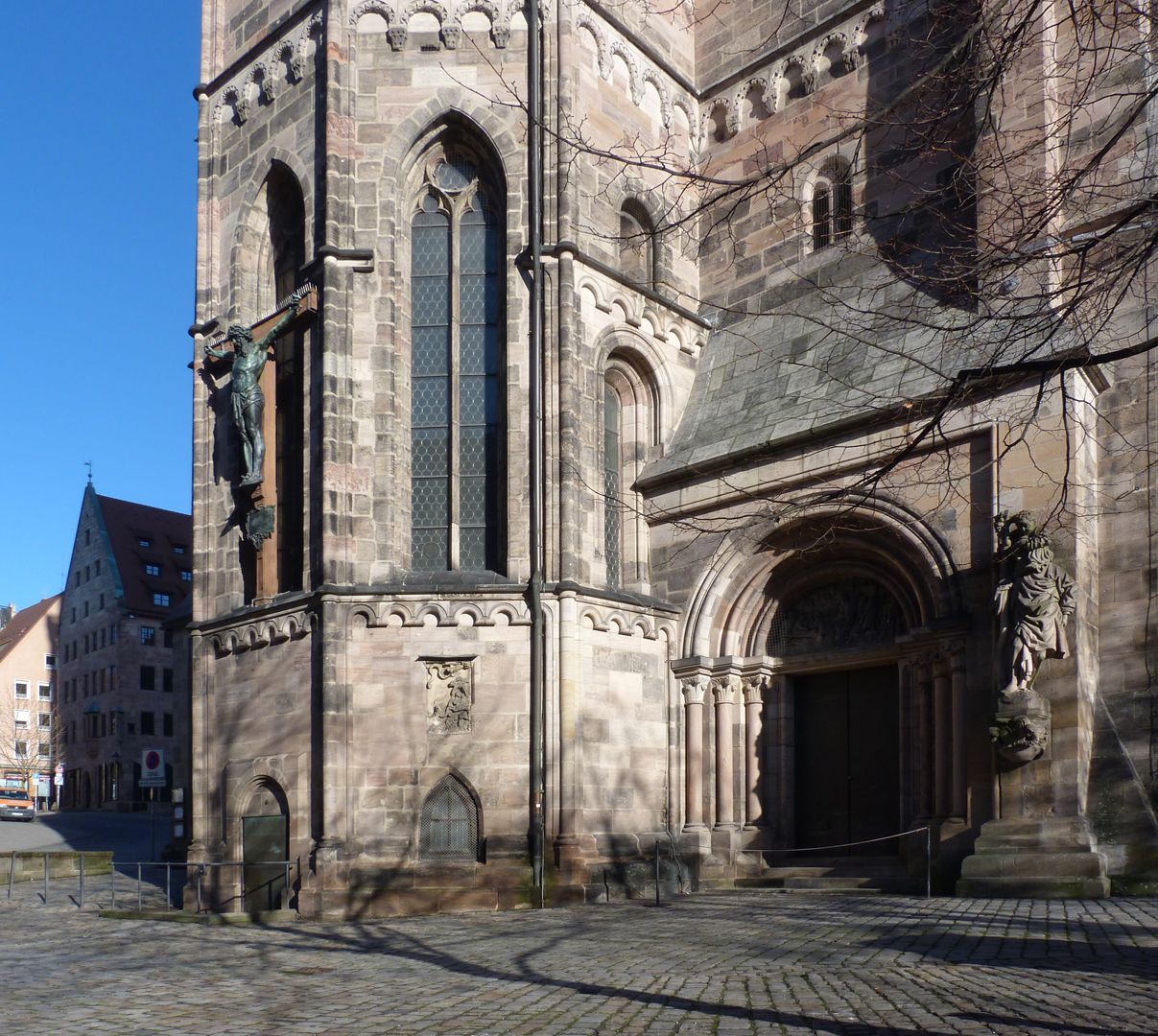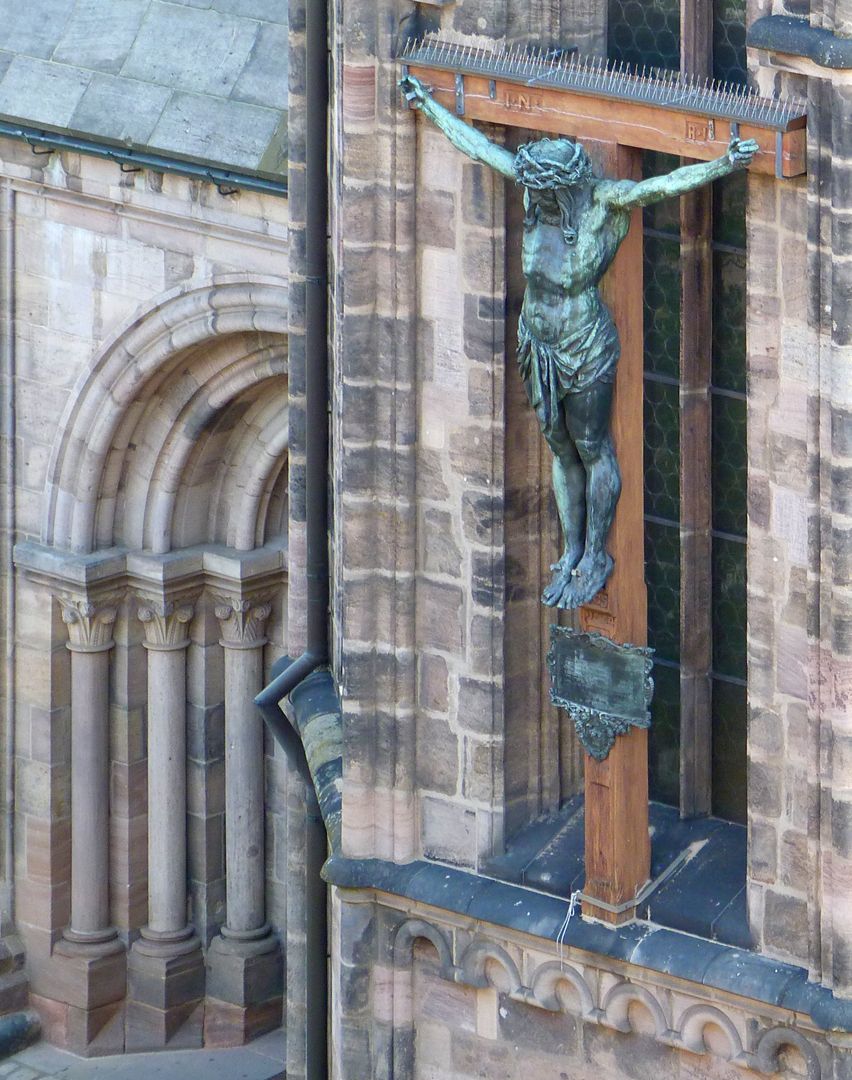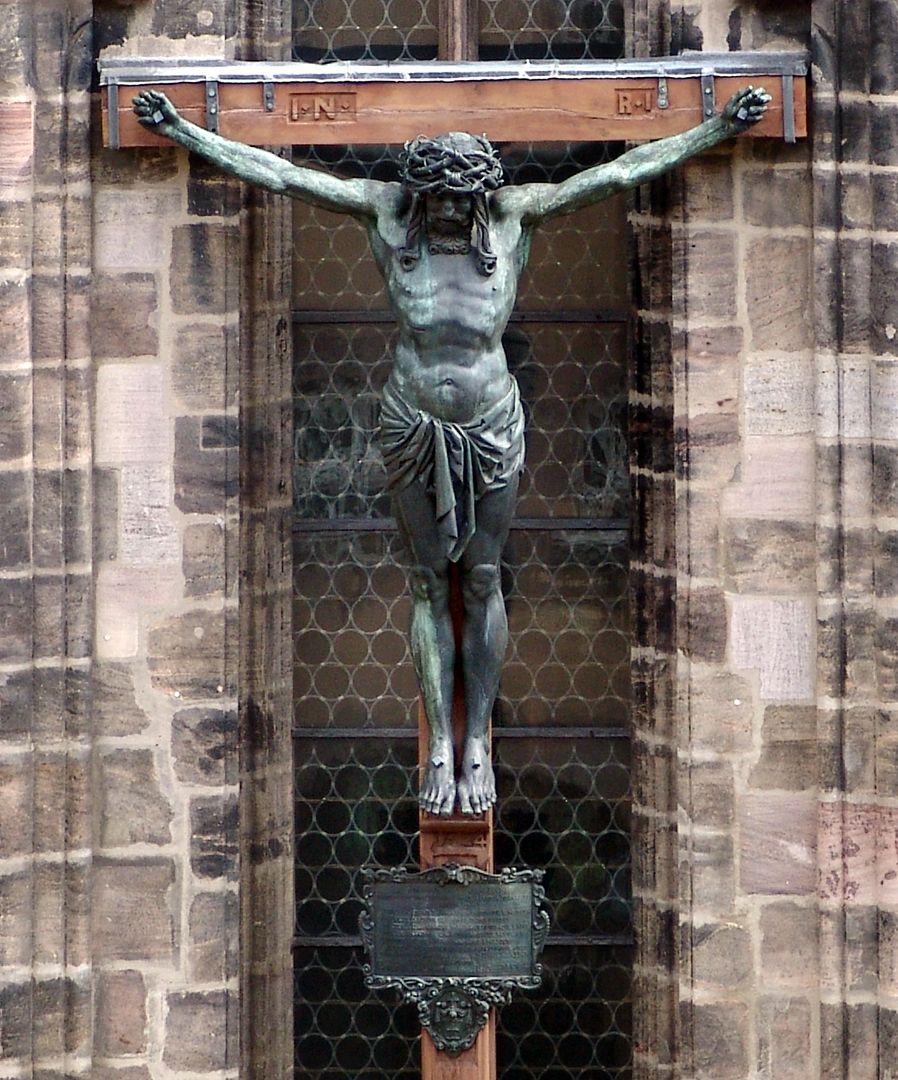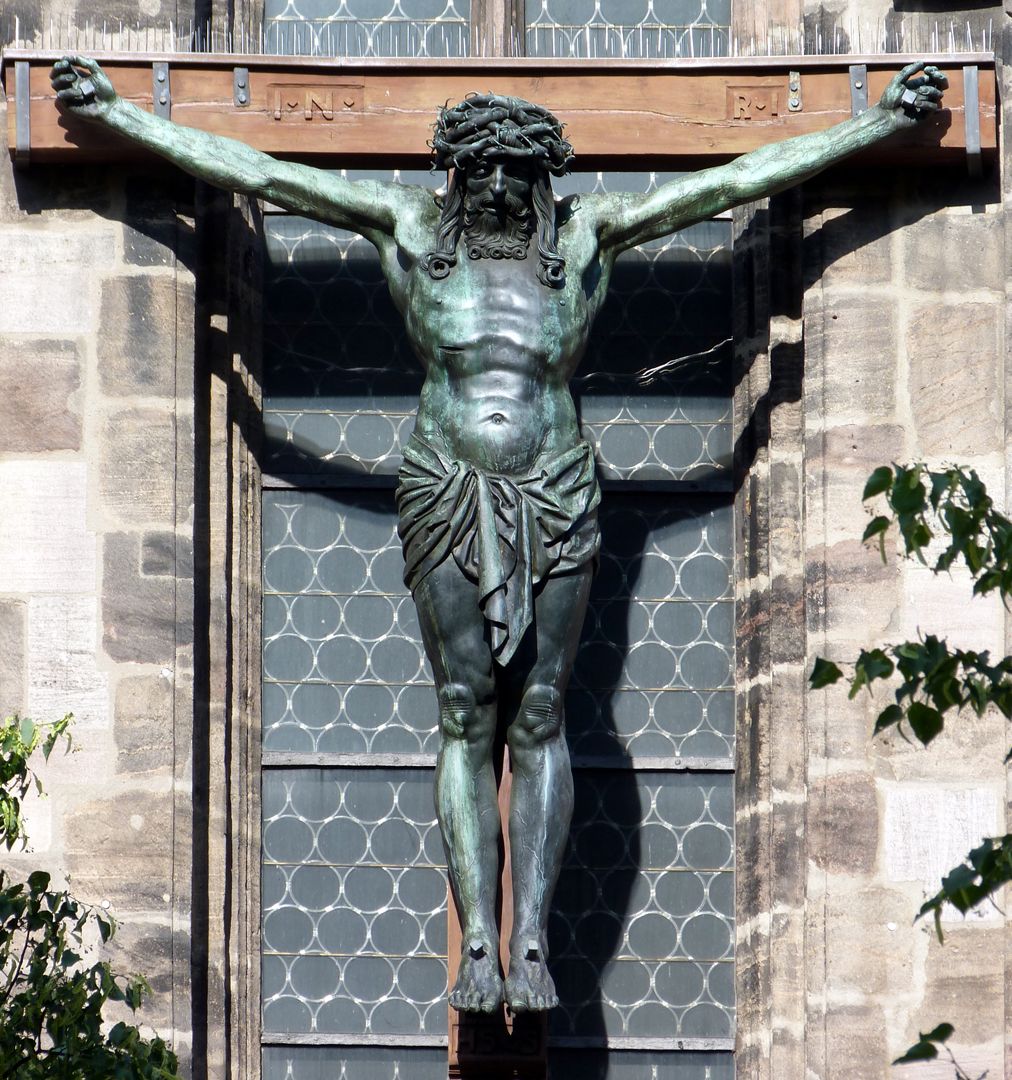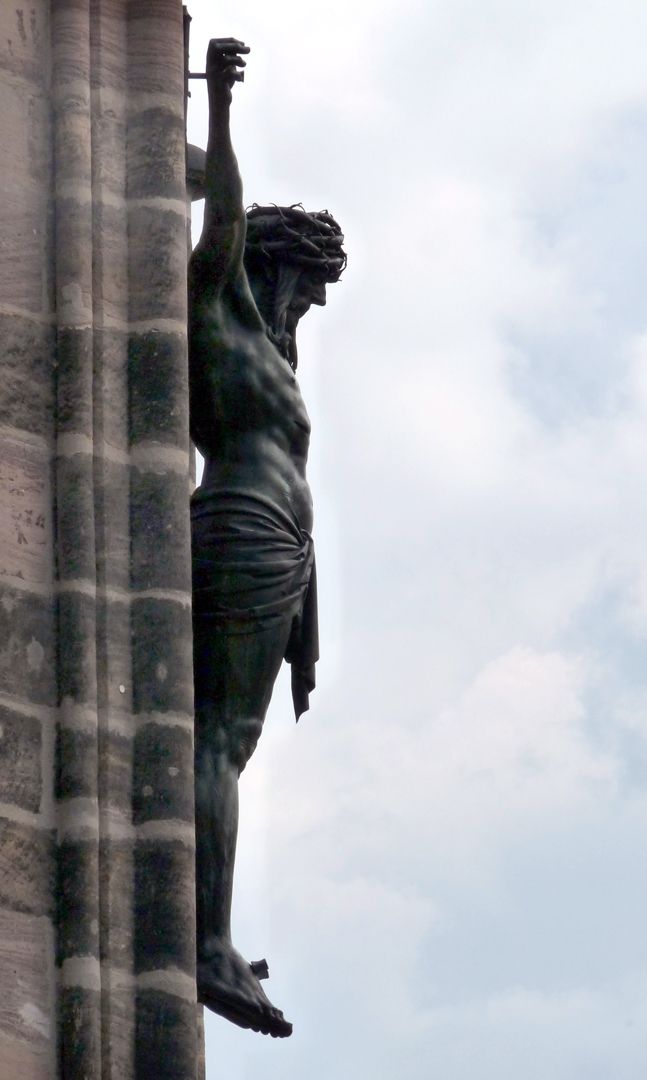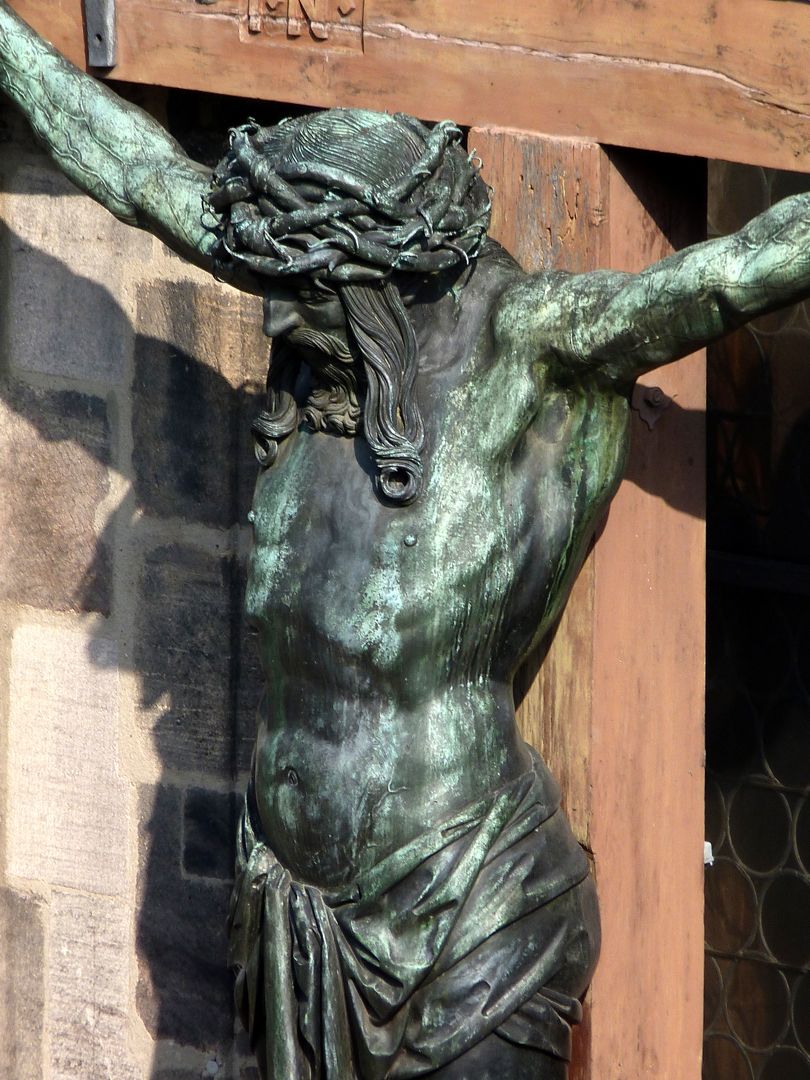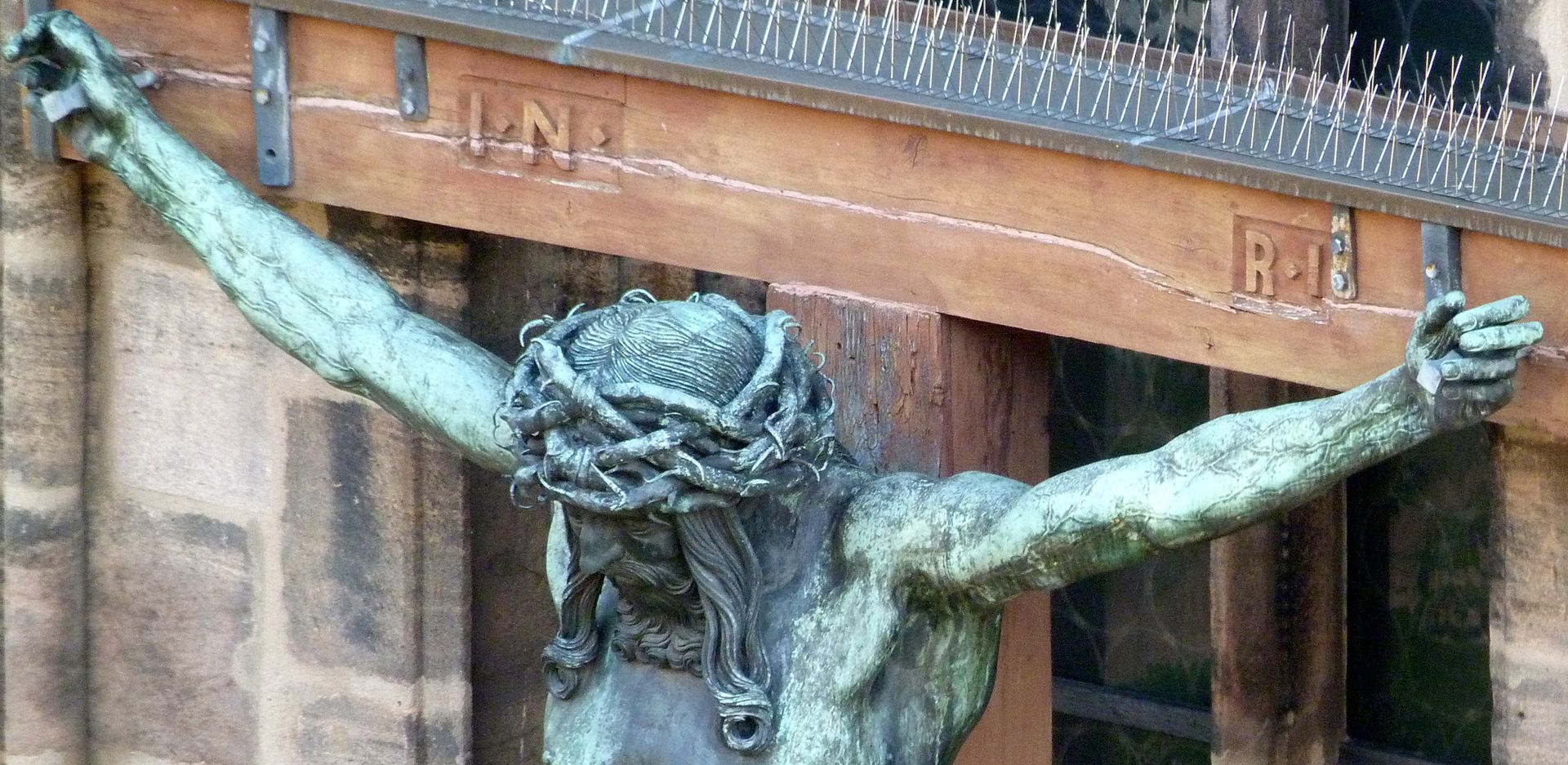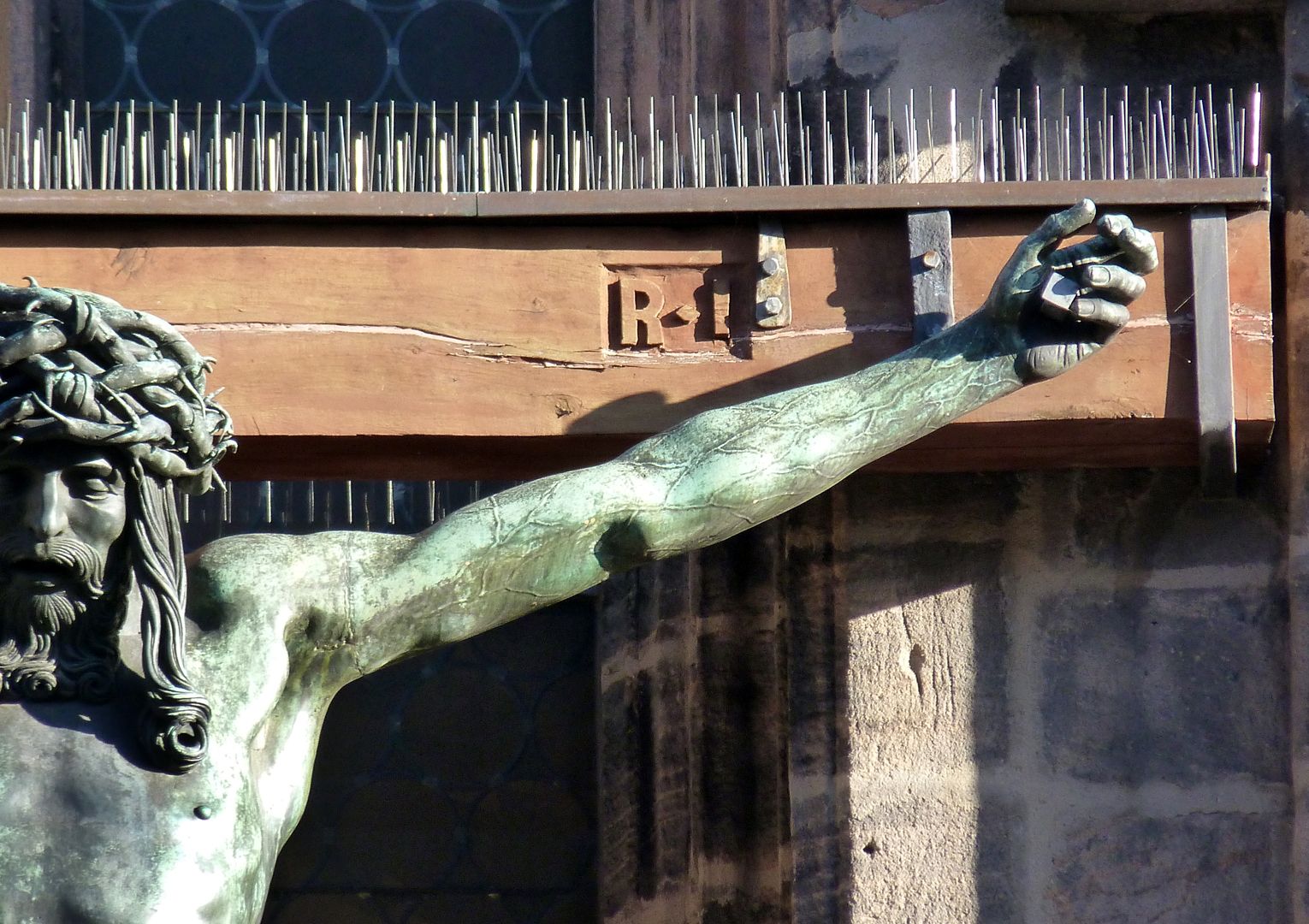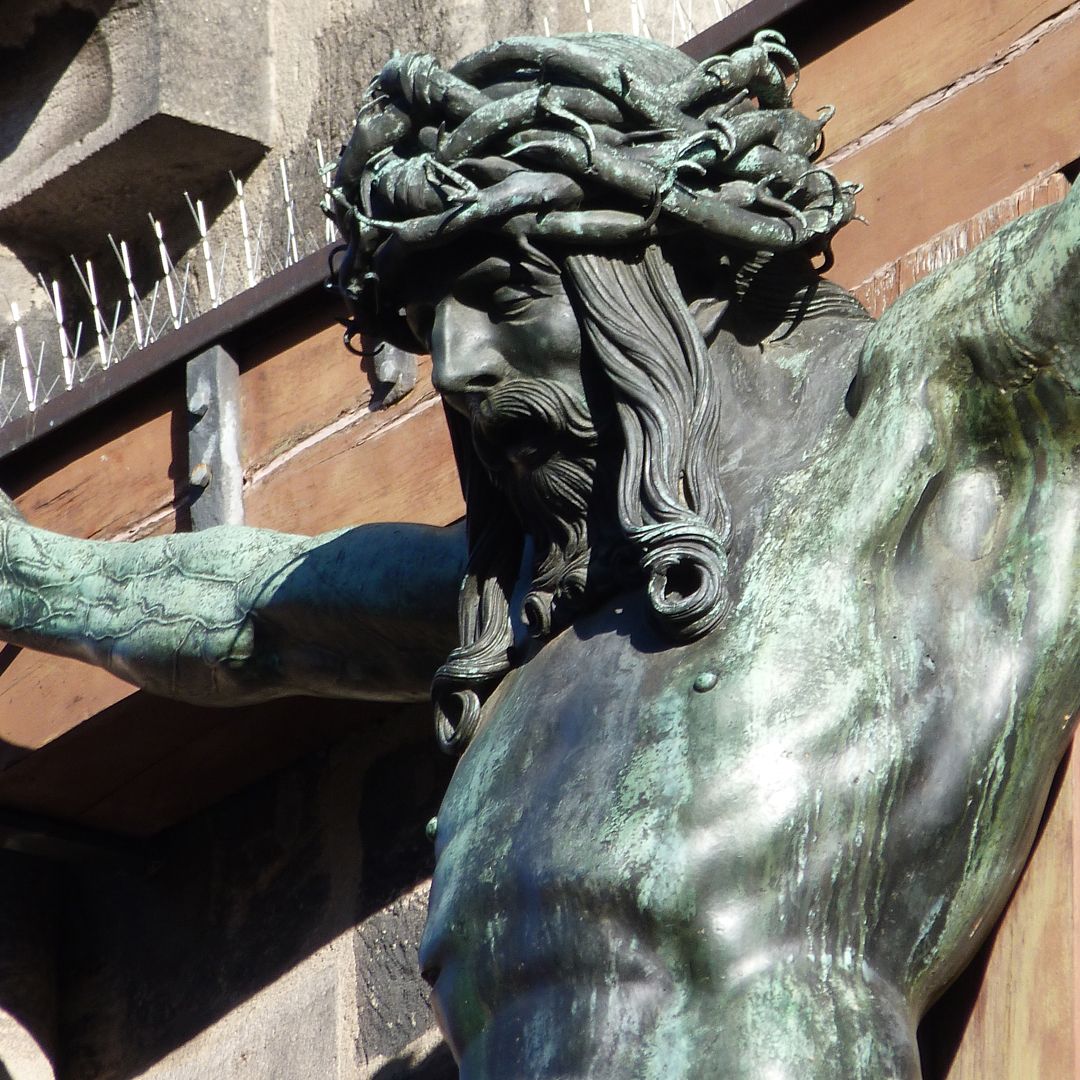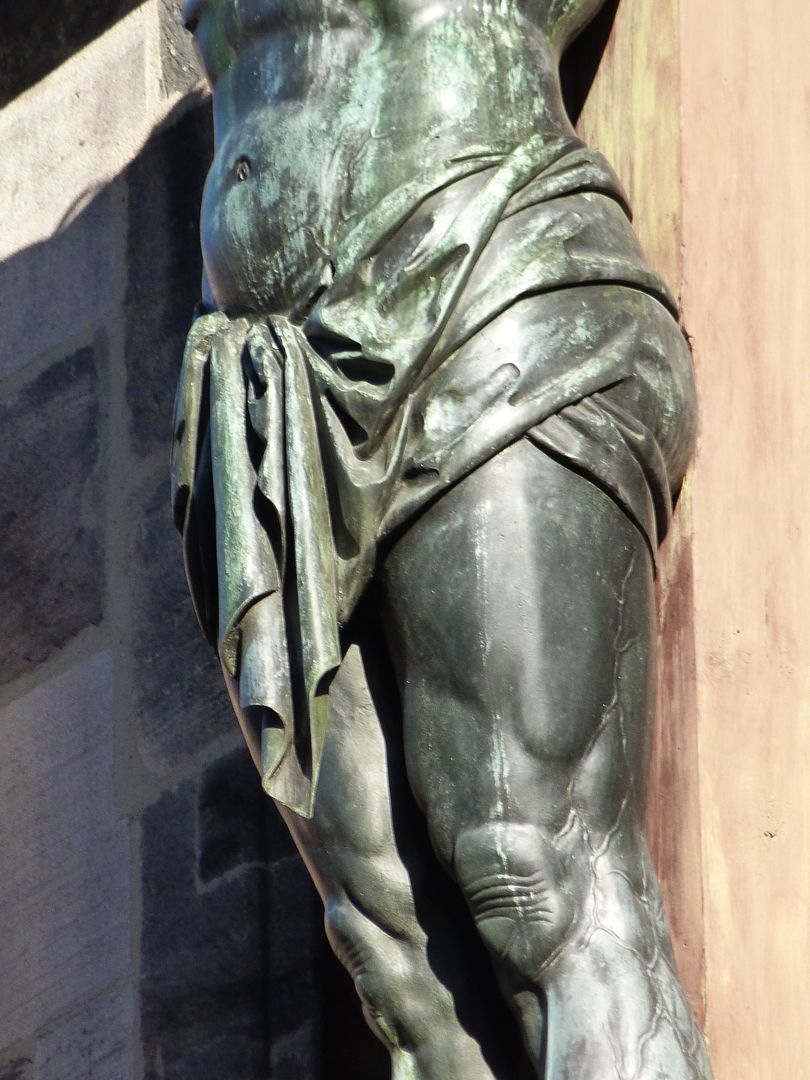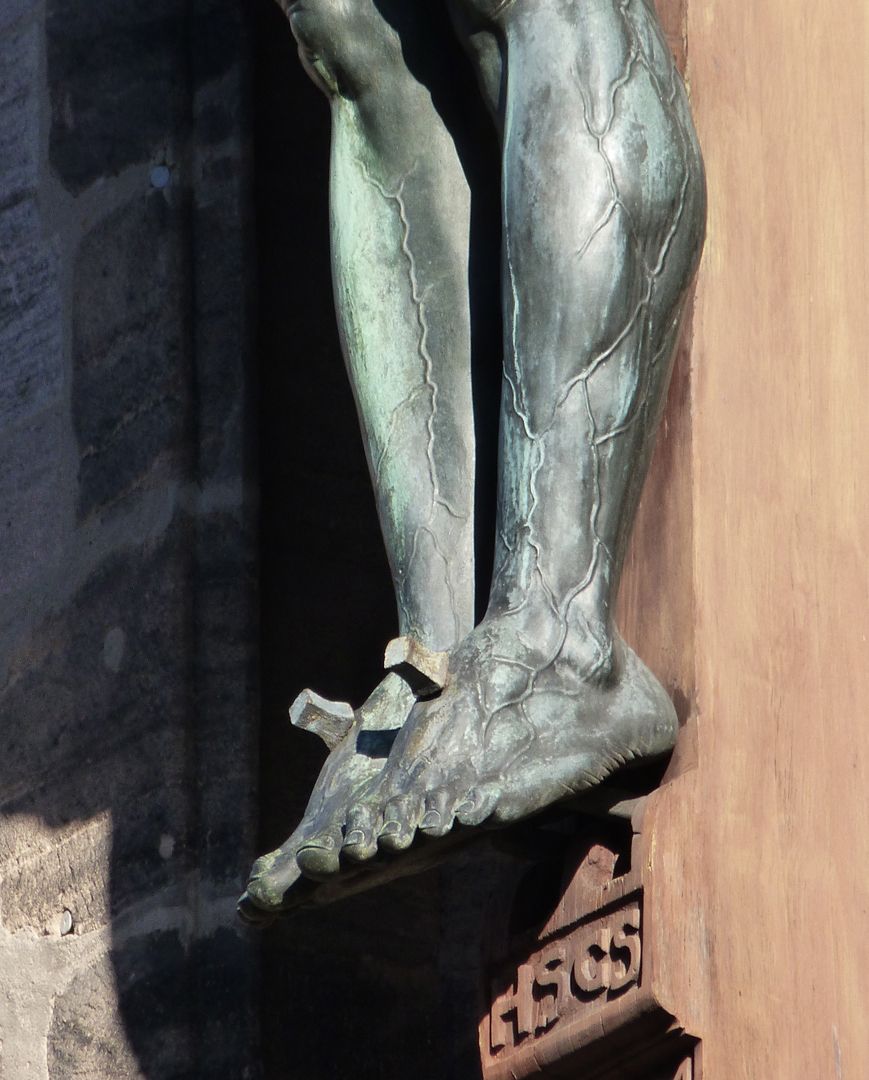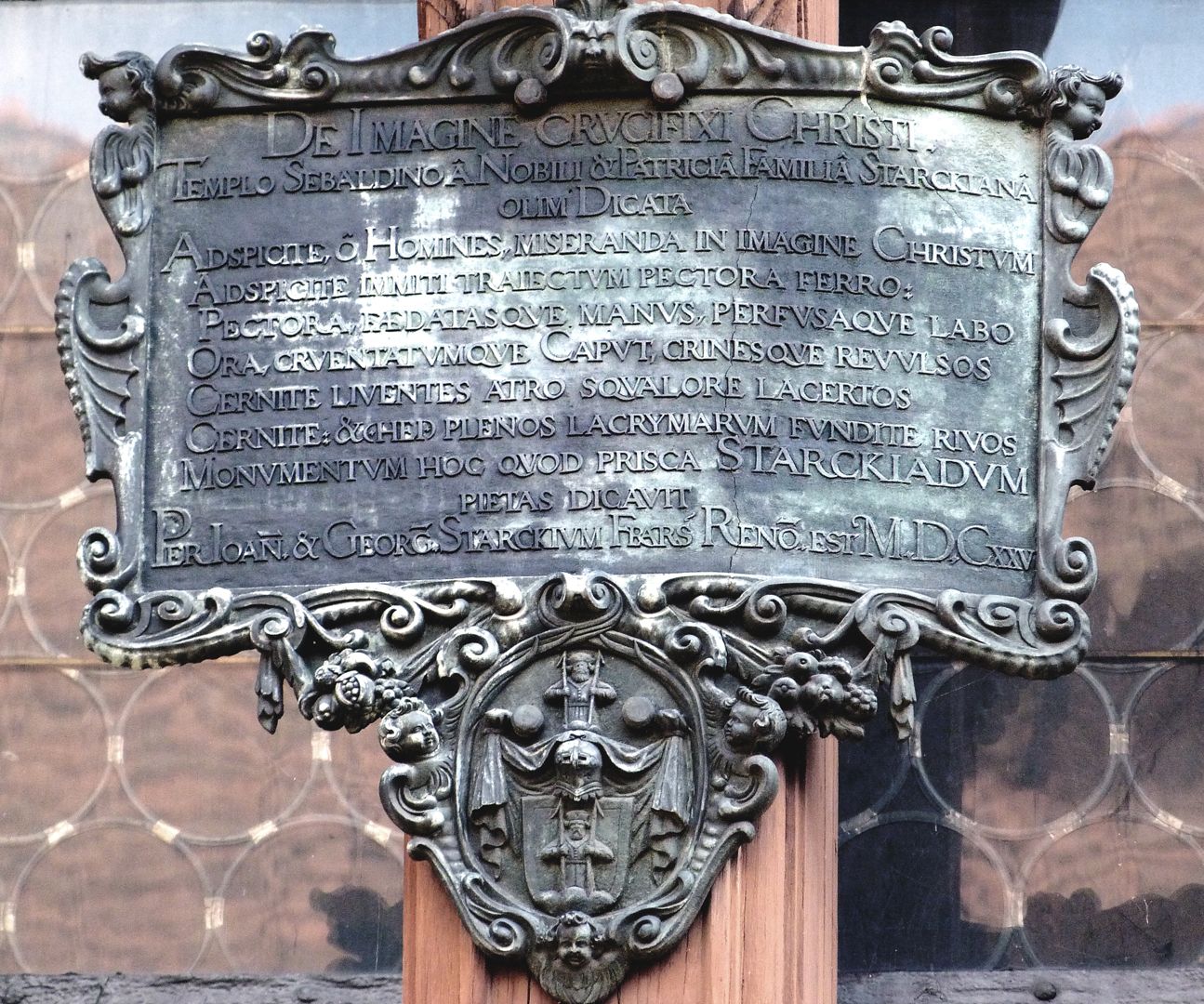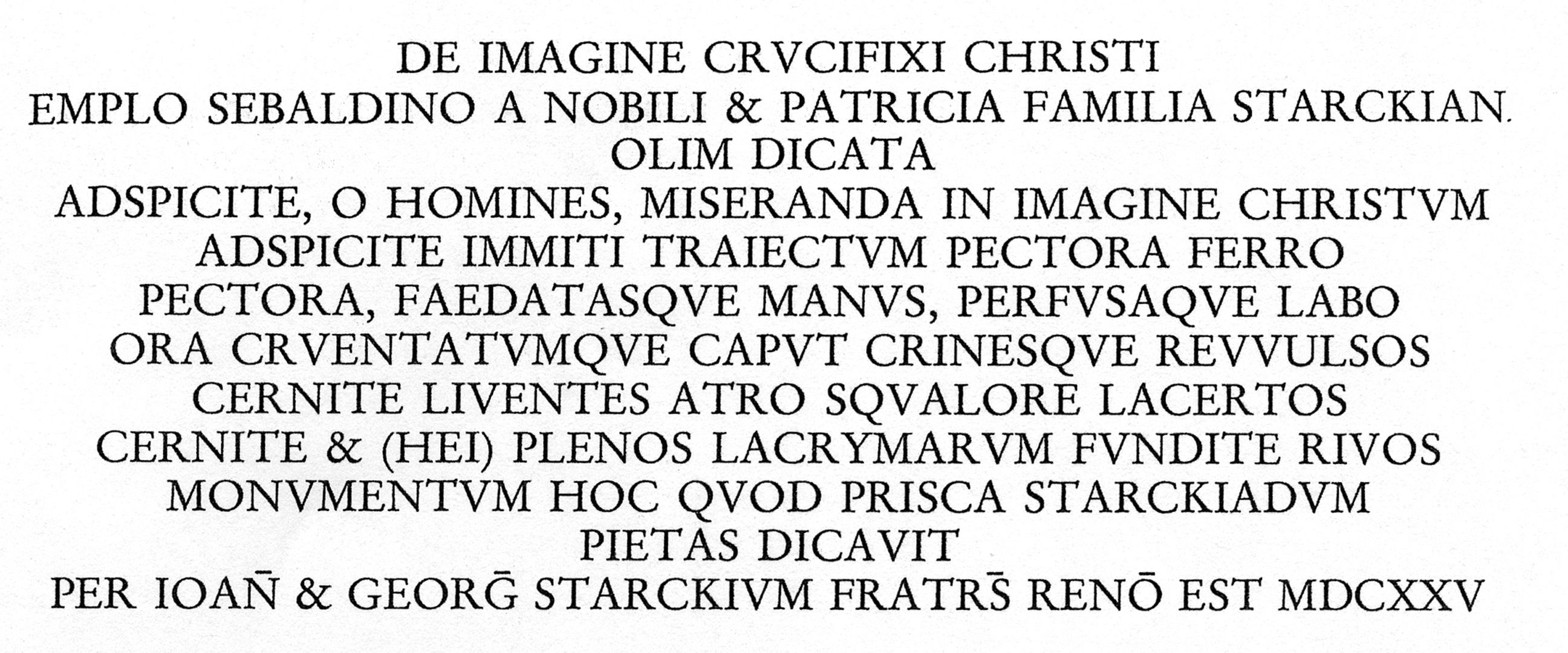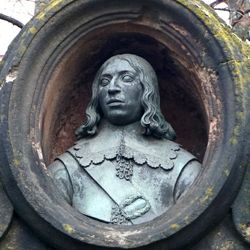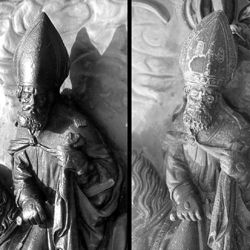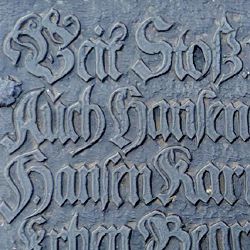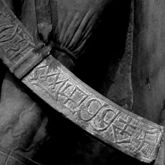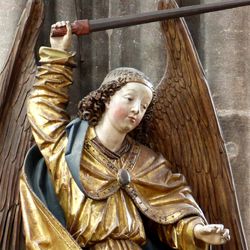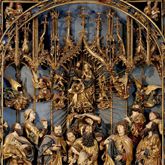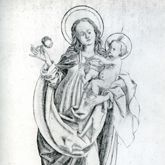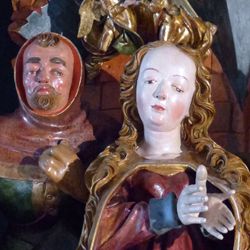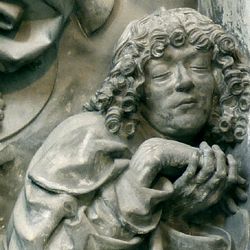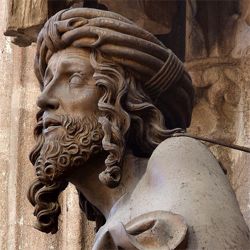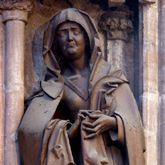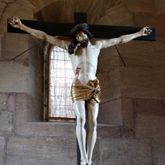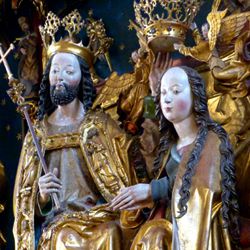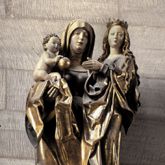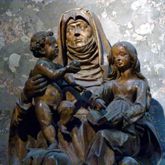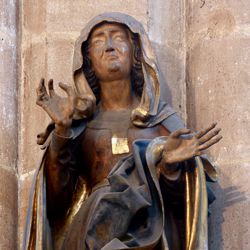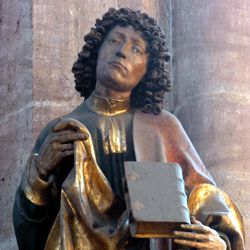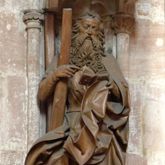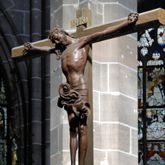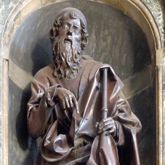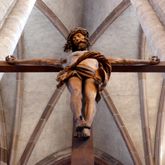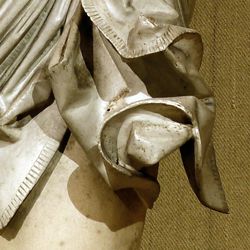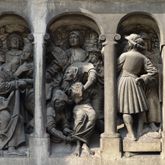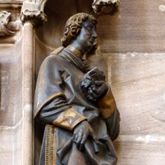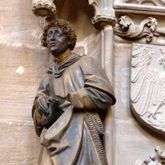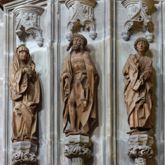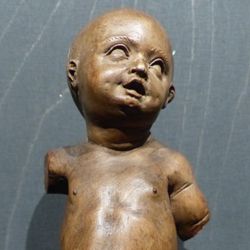Starck's crucifix
Starck's crucifix
around 1520
View from a worm's eye view
n the 2.80 m high figure of the crucified man with an arm span of 2.60 m, the extremities were cast separately and joined to the torso. For a long time, the crucifix located on the outside of the west choir of St. Sebald was considered a work of the 17th century because of the plaque there, which reports on a restoration from 1625 on behalf of the brothers Johann and Georg from the Starck family by Hans Wurzelbauer and his workshop. The translation of the bottom two lines of the inscription reads according to Karl Kohn: "This monument, which was founded by the tried and tested piety of the Starcken, was renewed by the brothers Johann and Georg Starck in 1625". By council resolution of September 18, 1618, the Starck family was allowed to have the crucifix donated by their foreparents removed and inspected for any damage. In addition, it was permitted to place a brass plaque on which the foundation was mentioned by the ancestors. In 1981, Karl Kohn showed that the crucifix, which used to stand in the northwestern part of the cemetery around the church of St. Sebald, between the rectory and the "zum Bratwurstglöcklein" food stall attached to the Moritz chapel, must be much older. It is mentioned there in a council decree dated December 1, 1542 because it got in the way of the construction of a waterway from the town hall to the castle bastions and had to be moved. It was intended to be placed on the outside of the west choir of St. Sebald, which according to the chronicles happened on May 10, 1543. However, the earliest reliable evidence of the crucifix dates back to June 5, 1530, when the potter Hans Nickel, "who wanted to make the Venetian potter's work [majolica]", was given the kennel south of the Lauferschlagturm by council decision in exchange for interest payment for one year for the construction of his smelting furnace should be where they once “poured the big hergot inside”. Veit Stoss had already been granted such a kennel for foundry work in 1514, which is why Karl Kohn said that the crucifix was also created at that time. Johann Gabriel Doppelmayr had already made an early attribution to Veit Stoss as a handwritten note in his bulletproof copy of the work "Historische Nachrichten Von den Nürnbergische Mathematicis und Künstler" (Historical Message from the Nürnbergische Mathematicis und Künstler), which he wrote and published in 1730 (GNM, Hs 108571, after p. 192). Heinz Stafski strongly objected to the assignment based on style-critical observations. The rather massive-looking body of the crucified man in no way corresponds to the well-known works of Veit Stoss, as a comparison with the crucifix in the east choir of the Sebaldus Church, dated 1520 and donated by Nicolaus Wickel and his son-in-law Augustin Tichtel, shows. Karl Kohn drew attention to a council resolution of April 30, 1520, according to which Ulrich Starck was granted a linden tree from the Reichswald for a picture carving that was to serve as a casting model: "Ulrich Starcken should be given a linden tree from the forest and molded over it ain cast on the columns on the rise between the parish and sant Moritzen churches". One could think of a cast model for the crucifix that was carved by a contemporary of Veit Stoss, who is now unknown; The location mentioned in the council decision would correspond to where the brass crucifix was located in 1542. In 1508, Ulrich Starck is documented as the owner of the house at Winklerstrasse 37, which still exists today, west of St. Sebald, where he lived until his death in 1549, so he lived to see the crucifix attached to the outside of the west choir of St. Sebald. The cemetery was finally closed by council decision of July 28, 1520, when there was an epidemic of plague; from then on, the deceased from the parish of St. Sebald had to be buried in the Johannisfriedhof. In 1526/27 the former churchyard of St. Sebald was paved. According to the council decree of July 12, 1533, it was intended to discuss where the crucifix, which was now quite abandoned, should be placed; it was installed in the west choir of St. Sebald ten years later. Lit.: Karl Kohn: The Starck Crucifix - A work by Veit Stoss, in: MVGN 68, 1981, pp. 297-302. Klaus Pechstein: The large brass crucifix of St. Sebald from the first half of the 16th century, in: MVGN 70, 1983, pp. 1-7. Heinz Stafski. The brass crucifix of St. Sebald - not a work by Veit Stoss, in: MVGN 70, 1983, pp. 8-12.Feedback geben
Location: Nuremberg, St. Sebald, west choir
Realization: Wurzelbauer, Johann (Hans), Stoss, Veit
photo 2010, Theo Noll
Starck's crucifix
around 1520
West choir and south tower portal
n the 2.80 m high figure of the crucified man with an arm span of 2.60 m, the extremities were cast separately and joined to the torso. For a long time, the crucifix located on the outside of the west choir of St. Sebald was considered a work of the 17th century because of the plaque there, which reports on a restoration from 1625 on behalf of the brothers Johann and Georg from the Starck family by Hans Wurzelbauer and his workshop. The translation of the bottom two lines of the inscription reads according to Karl Kohn: "This monument, which was founded by the tried and tested piety of the Starcken, was renewed by the brothers Johann and Georg Starck in 1625". By council resolution of September 18, 1618, the Starck family was allowed to have the crucifix donated by their foreparents removed and inspected for any damage. In addition, it was permitted to place a brass plaque on which the foundation was mentioned by the ancestors. In 1981, Karl Kohn showed that the crucifix, which used to stand in the northwestern part of the cemetery around the church of St. Sebald, between the rectory and the "zum Bratwurstglöcklein" food stall attached to the Moritz chapel, must be much older. It is mentioned there in a council decree dated December 1, 1542 because it got in the way of the construction of a waterway from the town hall to the castle bastions and had to be moved. It was intended to be placed on the outside of the west choir of St. Sebald, which according to the chronicles happened on May 10, 1543. However, the earliest reliable evidence of the crucifix dates back to June 5, 1530, when the potter Hans Nickel, "who wanted to make the Venetian potter's work [majolica]", was given the kennel south of the Lauferschlagturm by council decision in exchange for interest payment for one year for the construction of his smelting furnace should be where they once “poured the big hergot inside”. Veit Stoss had already been granted such a kennel for foundry work in 1514, which is why Karl Kohn said that the crucifix was also created at that time. Johann Gabriel Doppelmayr had already made an early attribution to Veit Stoss as a handwritten note in his bulletproof copy of the work "Historische Nachrichten Von den Nürnbergische Mathematicis und Künstler" (Historical Message from the Nürnbergische Mathematicis und Künstler), which he wrote and published in 1730 (GNM, Hs 108571, after p. 192). Heinz Stafski strongly objected to the assignment based on style-critical observations. The rather massive-looking body of the crucified man in no way corresponds to the well-known works of Veit Stoss, as a comparison with the crucifix in the east choir of the Sebaldus Church, dated 1520 and donated by Nicolaus Wickel and his son-in-law Augustin Tichtel, shows. Karl Kohn drew attention to a council resolution of April 30, 1520, according to which Ulrich Starck was granted a linden tree from the Reichswald for a picture carving that was to serve as a casting model: "Ulrich Starcken should be given a linden tree from the forest and molded over it ain cast on the columns on the rise between the parish and sant Moritzen churches". One could think of a cast model for the crucifix that was carved by a contemporary of Veit Stoss, who is now unknown; The location mentioned in the council decision would correspond to where the brass crucifix was located in 1542. In 1508, Ulrich Starck is documented as the owner of the house at Winklerstrasse 37, which still exists today, west of St. Sebald, where he lived until his death in 1549, so he lived to see the crucifix attached to the outside of the west choir of St. Sebald. The cemetery was finally closed by council decision of July 28, 1520, when there was an epidemic of plague; from then on, the deceased from the parish of St. Sebald had to be buried in the Johannisfriedhof. In 1526/27 the former churchyard of St. Sebald was paved. According to the council decree of July 12, 1533, it was intended to discuss where the crucifix, which was now quite abandoned, should be placed; it was installed in the west choir of St. Sebald ten years later. Lit.: Karl Kohn: The Starck Crucifix - A work by Veit Stoss, in: MVGN 68, 1981, pp. 297-302. Klaus Pechstein: The large brass crucifix of St. Sebald from the first half of the 16th century, in: MVGN 70, 1983, pp. 1-7. Heinz Stafski. The brass crucifix of St. Sebald - not a work by Veit Stoss, in: MVGN 70, 1983, pp. 8-12.Feedback geben
Location: Nuremberg, St. Sebald, west choir
Realization: Wurzelbauer, Johann (Hans), Stoss, Veit
photo 2016, Theo Noll
Starck's crucifix
around 1520
North tower portal and central window of the west choir
n the 2.80 m high figure of the crucified man with an arm span of 2.60 m, the extremities were cast separately and joined to the torso. For a long time, the crucifix located on the outside of the west choir of St. Sebald was considered a work of the 17th century because of the plaque there, which reports on a restoration from 1625 on behalf of the brothers Johann and Georg from the Starck family by Hans Wurzelbauer and his workshop. The translation of the bottom two lines of the inscription reads according to Karl Kohn: "This monument, which was founded by the tried and tested piety of the Starcken, was renewed by the brothers Johann and Georg Starck in 1625". By council resolution of September 18, 1618, the Starck family was allowed to have the crucifix donated by their foreparents removed and inspected for any damage. In addition, it was permitted to place a brass plaque on which the foundation was mentioned by the ancestors. In 1981, Karl Kohn showed that the crucifix, which used to stand in the northwestern part of the cemetery around the church of St. Sebald, between the rectory and the "zum Bratwurstglöcklein" food stall attached to the Moritz chapel, must be much older. It is mentioned there in a council decree dated December 1, 1542 because it got in the way of the construction of a waterway from the town hall to the castle bastions and had to be moved. It was intended to be placed on the outside of the west choir of St. Sebald, which according to the chronicles happened on May 10, 1543. However, the earliest reliable evidence of the crucifix dates back to June 5, 1530, when the potter Hans Nickel, "who wanted to make the Venetian potter's work [majolica]", was given the kennel south of the Lauferschlagturm by council decision in exchange for interest payment for one year for the construction of his smelting furnace should be where they once “poured the big hergot inside”. Veit Stoss had already been granted such a kennel for foundry work in 1514, which is why Karl Kohn said that the crucifix was also created at that time. Johann Gabriel Doppelmayr had already made an early attribution to Veit Stoss as a handwritten note in his bulletproof copy of the work "Historische Nachrichten Von den Nürnbergische Mathematicis und Künstler" (Historical Message from the Nürnbergische Mathematicis und Künstler), which he wrote and published in 1730 (GNM, Hs 108571, after p. 192). Heinz Stafski strongly objected to the assignment based on style-critical observations. The rather massive-looking body of the crucified man in no way corresponds to the well-known works of Veit Stoss, as a comparison with the crucifix in the east choir of the Sebaldus Church, dated 1520 and donated by Nicolaus Wickel and his son-in-law Augustin Tichtel, shows. Karl Kohn drew attention to a council resolution of April 30, 1520, according to which Ulrich Starck was granted a linden tree from the Reichswald for a picture carving that was to serve as a casting model: "Ulrich Starcken should be given a linden tree from the forest and molded over it ain cast on the columns on the rise between the parish and sant Moritzen churches". One could think of a cast model for the crucifix that was carved by a contemporary of Veit Stoss, who is now unknown; The location mentioned in the council decision would correspond to where the brass crucifix was located in 1542. In 1508, Ulrich Starck is documented as the owner of the house at Winklerstrasse 37, which still exists today, west of St. Sebald, where he lived until his death in 1549, so he lived to see the crucifix attached to the outside of the west choir of St. Sebald. The cemetery was finally closed by council decision of July 28, 1520, when there was an epidemic of plague; from then on, the deceased from the parish of St. Sebald had to be buried in the Johannisfriedhof. In 1526/27 the former churchyard of St. Sebald was paved. According to the council decree of July 12, 1533, it was intended to discuss where the crucifix, which was now quite abandoned, should be placed; it was installed in the west choir of St. Sebald ten years later. Lit.: Karl Kohn: The Starck Crucifix - A work by Veit Stoss, in: MVGN 68, 1981, pp. 297-302. Klaus Pechstein: The large brass crucifix of St. Sebald from the first half of the 16th century, in: MVGN 70, 1983, pp. 1-7. Heinz Stafski. The brass crucifix of St. Sebald - not a work by Veit Stoss, in: MVGN 70, 1983, pp. 8-12.Feedback geben
Location: Nuremberg, St. Sebald, west choir
Realization: Wurzelbauer, Johann (Hans), Stoss, Veit
photo 2017, Pablo de la Riestra
Starck's crucifix
around 1520
Crucifix in front of the window
n the 2.80 m high figure of the crucified man with an arm span of 2.60 m, the extremities were cast separately and joined to the torso. For a long time, the crucifix located on the outside of the west choir of St. Sebald was considered a work of the 17th century because of the plaque there, which reports on a restoration from 1625 on behalf of the brothers Johann and Georg from the Starck family by Hans Wurzelbauer and his workshop. The translation of the bottom two lines of the inscription reads according to Karl Kohn: "This monument, which was founded by the tried and tested piety of the Starcken, was renewed by the brothers Johann and Georg Starck in 1625". By council resolution of September 18, 1618, the Starck family was allowed to have the crucifix donated by their foreparents removed and inspected for any damage. In addition, it was permitted to place a brass plaque on which the foundation was mentioned by the ancestors. In 1981, Karl Kohn showed that the crucifix, which used to stand in the northwestern part of the cemetery around the church of St. Sebald, between the rectory and the "zum Bratwurstglöcklein" food stall attached to the Moritz chapel, must be much older. It is mentioned there in a council decree dated December 1, 1542 because it got in the way of the construction of a waterway from the town hall to the castle bastions and had to be moved. It was intended to be placed on the outside of the west choir of St. Sebald, which according to the chronicles happened on May 10, 1543. However, the earliest reliable evidence of the crucifix dates back to June 5, 1530, when the potter Hans Nickel, "who wanted to make the Venetian potter's work [majolica]", was given the kennel south of the Lauferschlagturm by council decision in exchange for interest payment for one year for the construction of his smelting furnace should be where they once “poured the big hergot inside”. Veit Stoss had already been granted such a kennel for foundry work in 1514, which is why Karl Kohn said that the crucifix was also created at that time. Johann Gabriel Doppelmayr had already made an early attribution to Veit Stoss as a handwritten note in his bulletproof copy of the work "Historische Nachrichten Von den Nürnbergische Mathematicis und Künstler" (Historical Message from the Nürnbergische Mathematicis und Künstler), which he wrote and published in 1730 (GNM, Hs 108571, after p. 192). Heinz Stafski strongly objected to the assignment based on style-critical observations. The rather massive-looking body of the crucified man in no way corresponds to the well-known works of Veit Stoss, as a comparison with the crucifix in the east choir of the Sebaldus Church, dated 1520 and donated by Nicolaus Wickel and his son-in-law Augustin Tichtel, shows. Karl Kohn drew attention to a council resolution of April 30, 1520, according to which Ulrich Starck was granted a linden tree from the Reichswald for a picture carving that was to serve as a casting model: "Ulrich Starcken should be given a linden tree from the forest and molded over it ain cast on the columns on the rise between the parish and sant Moritzen churches". One could think of a cast model for the crucifix that was carved by a contemporary of Veit Stoss, who is now unknown; The location mentioned in the council decision would correspond to where the brass crucifix was located in 1542. In 1508, Ulrich Starck is documented as the owner of the house at Winklerstrasse 37, which still exists today, west of St. Sebald, where he lived until his death in 1549, so he lived to see the crucifix attached to the outside of the west choir of St. Sebald. The cemetery was finally closed by council decision of July 28, 1520, when there was an epidemic of plague; from then on, the deceased from the parish of St. Sebald had to be buried in the Johannisfriedhof. In 1526/27 the former churchyard of St. Sebald was paved. According to the council decree of July 12, 1533, it was intended to discuss where the crucifix, which was now quite abandoned, should be placed; it was installed in the west choir of St. Sebald ten years later. Lit.: Karl Kohn: The Starck Crucifix - A work by Veit Stoss, in: MVGN 68, 1981, pp. 297-302. Klaus Pechstein: The large brass crucifix of St. Sebald from the first half of the 16th century, in: MVGN 70, 1983, pp. 1-7. Heinz Stafski. The brass crucifix of St. Sebald - not a work by Veit Stoss, in: MVGN 70, 1983, pp. 8-12.Feedback geben
Location: Nuremberg, St. Sebald, west choir
Realization: Wurzelbauer, Johann (Hans), Stoss, Veit
photo 2007, Pablo de la Riestra
Starck's crucifix
around 1520
Crucifix in front of the window
n the 2.80 m high figure of the crucified man with an arm span of 2.60 m, the extremities were cast separately and joined to the torso. For a long time, the crucifix located on the outside of the west choir of St. Sebald was considered a work of the 17th century because of the plaque there, which reports on a restoration from 1625 on behalf of the brothers Johann and Georg from the Starck family by Hans Wurzelbauer and his workshop. The translation of the bottom two lines of the inscription reads according to Karl Kohn: "This monument, which was founded by the tried and tested piety of the Starcken, was renewed by the brothers Johann and Georg Starck in 1625". By council resolution of September 18, 1618, the Starck family was allowed to have the crucifix donated by their foreparents removed and inspected for any damage. In addition, it was permitted to place a brass plaque on which the foundation was mentioned by the ancestors. In 1981, Karl Kohn showed that the crucifix, which used to stand in the northwestern part of the cemetery around the church of St. Sebald, between the rectory and the "zum Bratwurstglöcklein" food stall attached to the Moritz chapel, must be much older. It is mentioned there in a council decree dated December 1, 1542 because it got in the way of the construction of a waterway from the town hall to the castle bastions and had to be moved. It was intended to be placed on the outside of the west choir of St. Sebald, which according to the chronicles happened on May 10, 1543. However, the earliest reliable evidence of the crucifix dates back to June 5, 1530, when the potter Hans Nickel, "who wanted to make the Venetian potter's work [majolica]", was given the kennel south of the Lauferschlagturm by council decision in exchange for interest payment for one year for the construction of his smelting furnace should be where they once “poured the big hergot inside”. Veit Stoss had already been granted such a kennel for foundry work in 1514, which is why Karl Kohn said that the crucifix was also created at that time. Johann Gabriel Doppelmayr had already made an early attribution to Veit Stoss as a handwritten note in his bulletproof copy of the work "Historische Nachrichten Von den Nürnbergische Mathematicis und Künstler" (Historical Message from the Nürnbergische Mathematicis und Künstler), which he wrote and published in 1730 (GNM, Hs 108571, after p. 192). Heinz Stafski strongly objected to the assignment based on style-critical observations. The rather massive-looking body of the crucified man in no way corresponds to the well-known works of Veit Stoss, as a comparison with the crucifix in the east choir of the Sebaldus Church, dated 1520 and donated by Nicolaus Wickel and his son-in-law Augustin Tichtel, shows. Karl Kohn drew attention to a council resolution of April 30, 1520, according to which Ulrich Starck was granted a linden tree from the Reichswald for a picture carving that was to serve as a casting model: "Ulrich Starcken should be given a linden tree from the forest and molded over it ain cast on the columns on the rise between the parish and sant Moritzen churches". One could think of a cast model for the crucifix that was carved by a contemporary of Veit Stoss, who is now unknown; The location mentioned in the council decision would correspond to where the brass crucifix was located in 1542. In 1508, Ulrich Starck is documented as the owner of the house at Winklerstrasse 37, which still exists today, west of St. Sebald, where he lived until his death in 1549, so he lived to see the crucifix attached to the outside of the west choir of St. Sebald. The cemetery was finally closed by council decision of July 28, 1520, when there was an epidemic of plague; from then on, the deceased from the parish of St. Sebald had to be buried in the Johannisfriedhof. In 1526/27 the former churchyard of St. Sebald was paved. According to the council decree of July 12, 1533, it was intended to discuss where the crucifix, which was now quite abandoned, should be placed; it was installed in the west choir of St. Sebald ten years later. Lit.: Karl Kohn: The Starck Crucifix - A work by Veit Stoss, in: MVGN 68, 1981, pp. 297-302. Klaus Pechstein: The large brass crucifix of St. Sebald from the first half of the 16th century, in: MVGN 70, 1983, pp. 1-7. Heinz Stafski. The brass crucifix of St. Sebald - not a work by Veit Stoss, in: MVGN 70, 1983, pp. 8-12.Feedback geben
Location: Nuremberg, St. Sebald, west choir
Realization: Wurzelbauer, Johann (Hans), Stoss, Veit
photo 2014, Theo Noll
Starck's crucifix
around 1520
Lateral view from the north
n the 2.80 m high figure of the crucified man with an arm span of 2.60 m, the extremities were cast separately and joined to the torso. For a long time, the crucifix located on the outside of the west choir of St. Sebald was considered a work of the 17th century because of the plaque there, which reports on a restoration from 1625 on behalf of the brothers Johann and Georg from the Starck family by Hans Wurzelbauer and his workshop. The translation of the bottom two lines of the inscription reads according to Karl Kohn: "This monument, which was founded by the tried and tested piety of the Starcken, was renewed by the brothers Johann and Georg Starck in 1625". By council resolution of September 18, 1618, the Starck family was allowed to have the crucifix donated by their foreparents removed and inspected for any damage. In addition, it was permitted to place a brass plaque on which the foundation was mentioned by the ancestors. In 1981, Karl Kohn showed that the crucifix, which used to stand in the northwestern part of the cemetery around the church of St. Sebald, between the rectory and the "zum Bratwurstglöcklein" food stall attached to the Moritz chapel, must be much older. It is mentioned there in a council decree dated December 1, 1542 because it got in the way of the construction of a waterway from the town hall to the castle bastions and had to be moved. It was intended to be placed on the outside of the west choir of St. Sebald, which according to the chronicles happened on May 10, 1543. However, the earliest reliable evidence of the crucifix dates back to June 5, 1530, when the potter Hans Nickel, "who wanted to make the Venetian potter's work [majolica]", was given the kennel south of the Lauferschlagturm by council decision in exchange for interest payment for one year for the construction of his smelting furnace should be where they once “poured the big hergot inside”. Veit Stoss had already been granted such a kennel for foundry work in 1514, which is why Karl Kohn said that the crucifix was also created at that time. Johann Gabriel Doppelmayr had already made an early attribution to Veit Stoss as a handwritten note in his bulletproof copy of the work "Historische Nachrichten Von den Nürnbergische Mathematicis und Künstler" (Historical Message from the Nürnbergische Mathematicis und Künstler), which he wrote and published in 1730 (GNM, Hs 108571, after p. 192). Heinz Stafski strongly objected to the assignment based on style-critical observations. The rather massive-looking body of the crucified man in no way corresponds to the well-known works of Veit Stoss, as a comparison with the crucifix in the east choir of the Sebaldus Church, dated 1520 and donated by Nicolaus Wickel and his son-in-law Augustin Tichtel, shows. Karl Kohn drew attention to a council resolution of April 30, 1520, according to which Ulrich Starck was granted a linden tree from the Reichswald for a picture carving that was to serve as a casting model: "Ulrich Starcken should be given a linden tree from the forest and molded over it ain cast on the columns on the rise between the parish and sant Moritzen churches". One could think of a cast model for the crucifix that was carved by a contemporary of Veit Stoss, who is now unknown; The location mentioned in the council decision would correspond to where the brass crucifix was located in 1542. In 1508, Ulrich Starck is documented as the owner of the house at Winklerstrasse 37, which still exists today, west of St. Sebald, where he lived until his death in 1549, so he lived to see the crucifix attached to the outside of the west choir of St. Sebald. The cemetery was finally closed by council decision of July 28, 1520, when there was an epidemic of plague; from then on, the deceased from the parish of St. Sebald had to be buried in the Johannisfriedhof. In 1526/27 the former churchyard of St. Sebald was paved. According to the council decree of July 12, 1533, it was intended to discuss where the crucifix, which was now quite abandoned, should be placed; it was installed in the west choir of St. Sebald ten years later. Lit.: Karl Kohn: The Starck Crucifix - A work by Veit Stoss, in: MVGN 68, 1981, pp. 297-302. Klaus Pechstein: The large brass crucifix of St. Sebald from the first half of the 16th century, in: MVGN 70, 1983, pp. 1-7. Heinz Stafski. The brass crucifix of St. Sebald - not a work by Veit Stoss, in: MVGN 70, 1983, pp. 8-12.Feedback geben
Location: Nuremberg, St. Sebald, west choir
Realization: Wurzelbauer, Johann (Hans), Stoss, Veit
photo 2011, Theo Noll
Starck's crucifix
around 1520
Upper part of the body
n the 2.80 m high figure of the crucified man with an arm span of 2.60 m, the extremities were cast separately and joined to the torso. For a long time, the crucifix located on the outside of the west choir of St. Sebald was considered a work of the 17th century because of the plaque there, which reports on a restoration from 1625 on behalf of the brothers Johann and Georg from the Starck family by Hans Wurzelbauer and his workshop. The translation of the bottom two lines of the inscription reads according to Karl Kohn: "This monument, which was founded by the tried and tested piety of the Starcken, was renewed by the brothers Johann and Georg Starck in 1625". By council resolution of September 18, 1618, the Starck family was allowed to have the crucifix donated by their foreparents removed and inspected for any damage. In addition, it was permitted to place a brass plaque on which the foundation was mentioned by the ancestors. In 1981, Karl Kohn showed that the crucifix, which used to stand in the northwestern part of the cemetery around the church of St. Sebald, between the rectory and the "zum Bratwurstglöcklein" food stall attached to the Moritz chapel, must be much older. It is mentioned there in a council decree dated December 1, 1542 because it got in the way of the construction of a waterway from the town hall to the castle bastions and had to be moved. It was intended to be placed on the outside of the west choir of St. Sebald, which according to the chronicles happened on May 10, 1543. However, the earliest reliable evidence of the crucifix dates back to June 5, 1530, when the potter Hans Nickel, "who wanted to make the Venetian potter's work [majolica]", was given the kennel south of the Lauferschlagturm by council decision in exchange for interest payment for one year for the construction of his smelting furnace should be where they once “poured the big hergot inside”. Veit Stoss had already been granted such a kennel for foundry work in 1514, which is why Karl Kohn said that the crucifix was also created at that time. Johann Gabriel Doppelmayr had already made an early attribution to Veit Stoss as a handwritten note in his bulletproof copy of the work "Historische Nachrichten Von den Nürnbergische Mathematicis und Künstler" (Historical Message from the Nürnbergische Mathematicis und Künstler), which he wrote and published in 1730 (GNM, Hs 108571, after p. 192). Heinz Stafski strongly objected to the assignment based on style-critical observations. The rather massive-looking body of the crucified man in no way corresponds to the well-known works of Veit Stoss, as a comparison with the crucifix in the east choir of the Sebaldus Church, dated 1520 and donated by Nicolaus Wickel and his son-in-law Augustin Tichtel, shows. Karl Kohn drew attention to a council resolution of April 30, 1520, according to which Ulrich Starck was granted a linden tree from the Reichswald for a picture carving that was to serve as a casting model: "Ulrich Starcken should be given a linden tree from the forest and molded over it ain cast on the columns on the rise between the parish and sant Moritzen churches". One could think of a cast model for the crucifix that was carved by a contemporary of Veit Stoss, who is now unknown; The location mentioned in the council decision would correspond to where the brass crucifix was located in 1542. In 1508, Ulrich Starck is documented as the owner of the house at Winklerstrasse 37, which still exists today, west of St. Sebald, where he lived until his death in 1549, so he lived to see the crucifix attached to the outside of the west choir of St. Sebald. The cemetery was finally closed by council decision of July 28, 1520, when there was an epidemic of plague; from then on, the deceased from the parish of St. Sebald had to be buried in the Johannisfriedhof. In 1526/27 the former churchyard of St. Sebald was paved. According to the council decree of July 12, 1533, it was intended to discuss where the crucifix, which was now quite abandoned, should be placed; it was installed in the west choir of St. Sebald ten years later. Lit.: Karl Kohn: The Starck Crucifix - A work by Veit Stoss, in: MVGN 68, 1981, pp. 297-302. Klaus Pechstein: The large brass crucifix of St. Sebald from the first half of the 16th century, in: MVGN 70, 1983, pp. 1-7. Heinz Stafski. The brass crucifix of St. Sebald - not a work by Veit Stoss, in: MVGN 70, 1983, pp. 8-12.Feedback geben
Location: Nuremberg, St. Sebald, west choir
Realization: Wurzelbauer, Johann (Hans), Stoss, Veit
photo 2010, Theo Noll
Starck's crucifix
around 1520
Body
n the 2.80 m high figure of the crucified man with an arm span of 2.60 m, the extremities were cast separately and joined to the torso. For a long time, the crucifix located on the outside of the west choir of St. Sebald was considered a work of the 17th century because of the plaque there, which reports on a restoration from 1625 on behalf of the brothers Johann and Georg from the Starck family by Hans Wurzelbauer and his workshop. The translation of the bottom two lines of the inscription reads according to Karl Kohn: "This monument, which was founded by the tried and tested piety of the Starcken, was renewed by the brothers Johann and Georg Starck in 1625". By council resolution of September 18, 1618, the Starck family was allowed to have the crucifix donated by their foreparents removed and inspected for any damage. In addition, it was permitted to place a brass plaque on which the foundation was mentioned by the ancestors. In 1981, Karl Kohn showed that the crucifix, which used to stand in the northwestern part of the cemetery around the church of St. Sebald, between the rectory and the "zum Bratwurstglöcklein" food stall attached to the Moritz chapel, must be much older. It is mentioned there in a council decree dated December 1, 1542 because it got in the way of the construction of a waterway from the town hall to the castle bastions and had to be moved. It was intended to be placed on the outside of the west choir of St. Sebald, which according to the chronicles happened on May 10, 1543. However, the earliest reliable evidence of the crucifix dates back to June 5, 1530, when the potter Hans Nickel, "who wanted to make the Venetian potter's work [majolica]", was given the kennel south of the Lauferschlagturm by council decision in exchange for interest payment for one year for the construction of his smelting furnace should be where they once “poured the big hergot inside”. Veit Stoss had already been granted such a kennel for foundry work in 1514, which is why Karl Kohn said that the crucifix was also created at that time. Johann Gabriel Doppelmayr had already made an early attribution to Veit Stoss as a handwritten note in his bulletproof copy of the work "Historische Nachrichten Von den Nürnbergische Mathematicis und Künstler" (Historical Message from the Nürnbergische Mathematicis und Künstler), which he wrote and published in 1730 (GNM, Hs 108571, after p. 192). Heinz Stafski strongly objected to the assignment based on style-critical observations. The rather massive-looking body of the crucified man in no way corresponds to the well-known works of Veit Stoss, as a comparison with the crucifix in the east choir of the Sebaldus Church, dated 1520 and donated by Nicolaus Wickel and his son-in-law Augustin Tichtel, shows. Karl Kohn drew attention to a council resolution of April 30, 1520, according to which Ulrich Starck was granted a linden tree from the Reichswald for a picture carving that was to serve as a casting model: "Ulrich Starcken should be given a linden tree from the forest and molded over it ain cast on the columns on the rise between the parish and sant Moritzen churches". One could think of a cast model for the crucifix that was carved by a contemporary of Veit Stoss, who is now unknown; The location mentioned in the council decision would correspond to where the brass crucifix was located in 1542. In 1508, Ulrich Starck is documented as the owner of the house at Winklerstrasse 37, which still exists today, west of St. Sebald, where he lived until his death in 1549, so he lived to see the crucifix attached to the outside of the west choir of St. Sebald. The cemetery was finally closed by council decision of July 28, 1520, when there was an epidemic of plague; from then on, the deceased from the parish of St. Sebald had to be buried in the Johannisfriedhof. In 1526/27 the former churchyard of St. Sebald was paved. According to the council decree of July 12, 1533, it was intended to discuss where the crucifix, which was now quite abandoned, should be placed; it was installed in the west choir of St. Sebald ten years later. Lit.: Karl Kohn: The Starck Crucifix - A work by Veit Stoss, in: MVGN 68, 1981, pp. 297-302. Klaus Pechstein: The large brass crucifix of St. Sebald from the first half of the 16th century, in: MVGN 70, 1983, pp. 1-7. Heinz Stafski. The brass crucifix of St. Sebald - not a work by Veit Stoss, in: MVGN 70, 1983, pp. 8-12.Feedback geben
Location: Nuremberg, St. Sebald, west choir
Realization: Wurzelbauer, Johann (Hans), Stoss, Veit
photo 2010, Pablo de la Riestra
Starck's crucifix
around 1520
Arms and upper part of the body
photo 2017, Pablo de la Riestra
n the 2.80 m high figure of the crucified man with an arm span of 2.60 m, the extremities were cast separately and joined to the torso. For a long time, the crucifix located on the outside of the west choir of St. Sebald was considered a work of the 17th century because of the plaque there, which reports on a restoration from 1625 on behalf of the brothers Johann and Georg from the Starck family by Hans Wurzelbauer and his workshop. The translation of the bottom two lines of the inscription reads according to Karl Kohn: "This monument, which was founded by the tried and tested piety of the Starcken, was renewed by the brothers Johann and Georg Starck in 1625". By council resolution of September 18, 1618, the Starck family was allowed to have the crucifix donated by their foreparents removed and inspected for any damage. In addition, it was permitted to place a brass plaque on which the foundation was mentioned by the ancestors. In 1981, Karl Kohn showed that the crucifix, which used to stand in the northwestern part of the cemetery around the church of St. Sebald, between the rectory and the "zum Bratwurstglöcklein" food stall attached to the Moritz chapel, must be much older. It is mentioned there in a council decree dated December 1, 1542 because it got in the way of the construction of a waterway from the town hall to the castle bastions and had to be moved. It was intended to be placed on the outside of the west choir of St. Sebald, which according to the chronicles happened on May 10, 1543. However, the earliest reliable evidence of the crucifix dates back to June 5, 1530, when the potter Hans Nickel, "who wanted to make the Venetian potter's work [majolica]", was given the kennel south of the Lauferschlagturm by council decision in exchange for interest payment for one year for the construction of his smelting furnace should be where they once “poured the big hergot inside”. Veit Stoss had already been granted such a kennel for foundry work in 1514, which is why Karl Kohn said that the crucifix was also created at that time. Johann Gabriel Doppelmayr had already made an early attribution to Veit Stoss as a handwritten note in his bulletproof copy of the work "Historische Nachrichten Von den Nürnbergische Mathematicis und Künstler" (Historical Message from the Nürnbergische Mathematicis und Künstler), which he wrote and published in 1730 (GNM, Hs 108571, after p. 192). Heinz Stafski strongly objected to the assignment based on style-critical observations. The rather massive-looking body of the crucified man in no way corresponds to the well-known works of Veit Stoss, as a comparison with the crucifix in the east choir of the Sebaldus Church, dated 1520 and donated by Nicolaus Wickel and his son-in-law Augustin Tichtel, shows. Karl Kohn drew attention to a council resolution of April 30, 1520, according to which Ulrich Starck was granted a linden tree from the Reichswald for a picture carving that was to serve as a casting model: "Ulrich Starcken should be given a linden tree from the forest and molded over it ain cast on the columns on the rise between the parish and sant Moritzen churches". One could think of a cast model for the crucifix that was carved by a contemporary of Veit Stoss, who is now unknown; The location mentioned in the council decision would correspond to where the brass crucifix was located in 1542. In 1508, Ulrich Starck is documented as the owner of the house at Winklerstrasse 37, which still exists today, west of St. Sebald, where he lived until his death in 1549, so he lived to see the crucifix attached to the outside of the west choir of St. Sebald. The cemetery was finally closed by council decision of July 28, 1520, when there was an epidemic of plague; from then on, the deceased from the parish of St. Sebald had to be buried in the Johannisfriedhof. In 1526/27 the former churchyard of St. Sebald was paved. According to the council decree of July 12, 1533, it was intended to discuss where the crucifix, which was now quite abandoned, should be placed; it was installed in the west choir of St. Sebald ten years later. Lit.: Karl Kohn: The Starck Crucifix - A work by Veit Stoss, in: MVGN 68, 1981, pp. 297-302. Klaus Pechstein: The large brass crucifix of St. Sebald from the first half of the 16th century, in: MVGN 70, 1983, pp. 1-7. Heinz Stafski. The brass crucifix of St. Sebald - not a work by Veit Stoss, in: MVGN 70, 1983, pp. 8-12.Feedback geben
Location: Nuremberg, St. Sebald, west choir
Realization: Wurzelbauer, Johann (Hans), Stoss, Veit
Starck's crucifix
around 1520
left arm on the crossbar of the cross (seam between arm and upper body)
n the 2.80 m high figure of the crucified man with an arm span of 2.60 m, the extremities were cast separately and joined to the torso. For a long time, the crucifix located on the outside of the west choir of St. Sebald was considered a work of the 17th century because of the plaque there, which reports on a restoration from 1625 on behalf of the brothers Johann and Georg from the Starck family by Hans Wurzelbauer and his workshop. The translation of the bottom two lines of the inscription reads according to Karl Kohn: "This monument, which was founded by the tried and tested piety of the Starcken, was renewed by the brothers Johann and Georg Starck in 1625". By council resolution of September 18, 1618, the Starck family was allowed to have the crucifix donated by their foreparents removed and inspected for any damage. In addition, it was permitted to place a brass plaque on which the foundation was mentioned by the ancestors. In 1981, Karl Kohn showed that the crucifix, which used to stand in the northwestern part of the cemetery around the church of St. Sebald, between the rectory and the "zum Bratwurstglöcklein" food stall attached to the Moritz chapel, must be much older. It is mentioned there in a council decree dated December 1, 1542 because it got in the way of the construction of a waterway from the town hall to the castle bastions and had to be moved. It was intended to be placed on the outside of the west choir of St. Sebald, which according to the chronicles happened on May 10, 1543. However, the earliest reliable evidence of the crucifix dates back to June 5, 1530, when the potter Hans Nickel, "who wanted to make the Venetian potter's work [majolica]", was given the kennel south of the Lauferschlagturm by council decision in exchange for interest payment for one year for the construction of his smelting furnace should be where they once “poured the big hergot inside”. Veit Stoss had already been granted such a kennel for foundry work in 1514, which is why Karl Kohn said that the crucifix was also created at that time. Johann Gabriel Doppelmayr had already made an early attribution to Veit Stoss as a handwritten note in his bulletproof copy of the work "Historische Nachrichten Von den Nürnbergische Mathematicis und Künstler" (Historical Message from the Nürnbergische Mathematicis und Künstler), which he wrote and published in 1730 (GNM, Hs 108571, after p. 192). Heinz Stafski strongly objected to the assignment based on style-critical observations. The rather massive-looking body of the crucified man in no way corresponds to the well-known works of Veit Stoss, as a comparison with the crucifix in the east choir of the Sebaldus Church, dated 1520 and donated by Nicolaus Wickel and his son-in-law Augustin Tichtel, shows. Karl Kohn drew attention to a council resolution of April 30, 1520, according to which Ulrich Starck was granted a linden tree from the Reichswald for a picture carving that was to serve as a casting model: "Ulrich Starcken should be given a linden tree from the forest and molded over it ain cast on the columns on the rise between the parish and sant Moritzen churches". One could think of a cast model for the crucifix that was carved by a contemporary of Veit Stoss, who is now unknown; The location mentioned in the council decision would correspond to where the brass crucifix was located in 1542. In 1508, Ulrich Starck is documented as the owner of the house at Winklerstrasse 37, which still exists today, west of St. Sebald, where he lived until his death in 1549, so he lived to see the crucifix attached to the outside of the west choir of St. Sebald. The cemetery was finally closed by council decision of July 28, 1520, when there was an epidemic of plague; from then on, the deceased from the parish of St. Sebald had to be buried in the Johannisfriedhof. In 1526/27 the former churchyard of St. Sebald was paved. According to the council decree of July 12, 1533, it was intended to discuss where the crucifix, which was now quite abandoned, should be placed; it was installed in the west choir of St. Sebald ten years later. Lit.: Karl Kohn: The Starck Crucifix - A work by Veit Stoss, in: MVGN 68, 1981, pp. 297-302. Klaus Pechstein: The large brass crucifix of St. Sebald from the first half of the 16th century, in: MVGN 70, 1983, pp. 1-7. Heinz Stafski. The brass crucifix of St. Sebald - not a work by Veit Stoss, in: MVGN 70, 1983, pp. 8-12.Feedback geben
Location: Nuremberg, St. Sebald, west choir
Realization: Wurzelbauer, Johann (Hans), Stoss, Veit
photo 2016, Theo Noll
Starck's crucifix
around 1520
Upper body and head, side view from southwest
n the 2.80 m high figure of the crucified man with an arm span of 2.60 m, the extremities were cast separately and joined to the torso. For a long time, the crucifix located on the outside of the west choir of St. Sebald was considered a work of the 17th century because of the plaque there, which reports on a restoration from 1625 on behalf of the brothers Johann and Georg from the Starck family by Hans Wurzelbauer and his workshop. The translation of the bottom two lines of the inscription reads according to Karl Kohn: "This monument, which was founded by the tried and tested piety of the Starcken, was renewed by the brothers Johann and Georg Starck in 1625". By council resolution of September 18, 1618, the Starck family was allowed to have the crucifix donated by their foreparents removed and inspected for any damage. In addition, it was permitted to place a brass plaque on which the foundation was mentioned by the ancestors. In 1981, Karl Kohn showed that the crucifix, which used to stand in the northwestern part of the cemetery around the church of St. Sebald, between the rectory and the "zum Bratwurstglöcklein" food stall attached to the Moritz chapel, must be much older. It is mentioned there in a council decree dated December 1, 1542 because it got in the way of the construction of a waterway from the town hall to the castle bastions and had to be moved. It was intended to be placed on the outside of the west choir of St. Sebald, which according to the chronicles happened on May 10, 1543. However, the earliest reliable evidence of the crucifix dates back to June 5, 1530, when the potter Hans Nickel, "who wanted to make the Venetian potter's work [majolica]", was given the kennel south of the Lauferschlagturm by council decision in exchange for interest payment for one year for the construction of his smelting furnace should be where they once “poured the big hergot inside”. Veit Stoss had already been granted such a kennel for foundry work in 1514, which is why Karl Kohn said that the crucifix was also created at that time. Johann Gabriel Doppelmayr had already made an early attribution to Veit Stoss as a handwritten note in his bulletproof copy of the work "Historische Nachrichten Von den Nürnbergische Mathematicis und Künstler" (Historical Message from the Nürnbergische Mathematicis und Künstler), which he wrote and published in 1730 (GNM, Hs 108571, after p. 192). Heinz Stafski strongly objected to the assignment based on style-critical observations. The rather massive-looking body of the crucified man in no way corresponds to the well-known works of Veit Stoss, as a comparison with the crucifix in the east choir of the Sebaldus Church, dated 1520 and donated by Nicolaus Wickel and his son-in-law Augustin Tichtel, shows. Karl Kohn drew attention to a council resolution of April 30, 1520, according to which Ulrich Starck was granted a linden tree from the Reichswald for a picture carving that was to serve as a casting model: "Ulrich Starcken should be given a linden tree from the forest and molded over it ain cast on the columns on the rise between the parish and sant Moritzen churches". One could think of a cast model for the crucifix that was carved by a contemporary of Veit Stoss, who is now unknown; The location mentioned in the council decision would correspond to where the brass crucifix was located in 1542. In 1508, Ulrich Starck is documented as the owner of the house at Winklerstrasse 37, which still exists today, west of St. Sebald, where he lived until his death in 1549, so he lived to see the crucifix attached to the outside of the west choir of St. Sebald. The cemetery was finally closed by council decision of July 28, 1520, when there was an epidemic of plague; from then on, the deceased from the parish of St. Sebald had to be buried in the Johannisfriedhof. In 1526/27 the former churchyard of St. Sebald was paved. According to the council decree of July 12, 1533, it was intended to discuss where the crucifix, which was now quite abandoned, should be placed; it was installed in the west choir of St. Sebald ten years later. Lit.: Karl Kohn: The Starck Crucifix - A work by Veit Stoss, in: MVGN 68, 1981, pp. 297-302. Klaus Pechstein: The large brass crucifix of St. Sebald from the first half of the 16th century, in: MVGN 70, 1983, pp. 1-7. Heinz Stafski. The brass crucifix of St. Sebald - not a work by Veit Stoss, in: MVGN 70, 1983, pp. 8-12.Feedback geben
Location: Nuremberg, St. Sebald, west choir
Realization: Wurzelbauer, Johann (Hans), Stoss, Veit
photo 2016, Theo Noll
Starck's crucifix
around 1520
Detail view with loin cloth
n the 2.80 m high figure of the crucified man with an arm span of 2.60 m, the extremities were cast separately and joined to the torso. For a long time, the crucifix located on the outside of the west choir of St. Sebald was considered a work of the 17th century because of the plaque there, which reports on a restoration from 1625 on behalf of the brothers Johann and Georg from the Starck family by Hans Wurzelbauer and his workshop. The translation of the bottom two lines of the inscription reads according to Karl Kohn: "This monument, which was founded by the tried and tested piety of the Starcken, was renewed by the brothers Johann and Georg Starck in 1625". By council resolution of September 18, 1618, the Starck family was allowed to have the crucifix donated by their foreparents removed and inspected for any damage. In addition, it was permitted to place a brass plaque on which the foundation was mentioned by the ancestors. In 1981, Karl Kohn showed that the crucifix, which used to stand in the northwestern part of the cemetery around the church of St. Sebald, between the rectory and the "zum Bratwurstglöcklein" food stall attached to the Moritz chapel, must be much older. It is mentioned there in a council decree dated December 1, 1542 because it got in the way of the construction of a waterway from the town hall to the castle bastions and had to be moved. It was intended to be placed on the outside of the west choir of St. Sebald, which according to the chronicles happened on May 10, 1543. However, the earliest reliable evidence of the crucifix dates back to June 5, 1530, when the potter Hans Nickel, "who wanted to make the Venetian potter's work [majolica]", was given the kennel south of the Lauferschlagturm by council decision in exchange for interest payment for one year for the construction of his smelting furnace should be where they once “poured the big hergot inside”. Veit Stoss had already been granted such a kennel for foundry work in 1514, which is why Karl Kohn said that the crucifix was also created at that time. Johann Gabriel Doppelmayr had already made an early attribution to Veit Stoss as a handwritten note in his bulletproof copy of the work "Historische Nachrichten Von den Nürnbergische Mathematicis und Künstler" (Historical Message from the Nürnbergische Mathematicis und Künstler), which he wrote and published in 1730 (GNM, Hs 108571, after p. 192). Heinz Stafski strongly objected to the assignment based on style-critical observations. The rather massive-looking body of the crucified man in no way corresponds to the well-known works of Veit Stoss, as a comparison with the crucifix in the east choir of the Sebaldus Church, dated 1520 and donated by Nicolaus Wickel and his son-in-law Augustin Tichtel, shows. Karl Kohn drew attention to a council resolution of April 30, 1520, according to which Ulrich Starck was granted a linden tree from the Reichswald for a picture carving that was to serve as a casting model: "Ulrich Starcken should be given a linden tree from the forest and molded over it ain cast on the columns on the rise between the parish and sant Moritzen churches". One could think of a cast model for the crucifix that was carved by a contemporary of Veit Stoss, who is now unknown; The location mentioned in the council decision would correspond to where the brass crucifix was located in 1542. In 1508, Ulrich Starck is documented as the owner of the house at Winklerstrasse 37, which still exists today, west of St. Sebald, where he lived until his death in 1549, so he lived to see the crucifix attached to the outside of the west choir of St. Sebald. The cemetery was finally closed by council decision of July 28, 1520, when there was an epidemic of plague; from then on, the deceased from the parish of St. Sebald had to be buried in the Johannisfriedhof. In 1526/27 the former churchyard of St. Sebald was paved. According to the council decree of July 12, 1533, it was intended to discuss where the crucifix, which was now quite abandoned, should be placed; it was installed in the west choir of St. Sebald ten years later. Lit.: Karl Kohn: The Starck Crucifix - A work by Veit Stoss, in: MVGN 68, 1981, pp. 297-302. Klaus Pechstein: The large brass crucifix of St. Sebald from the first half of the 16th century, in: MVGN 70, 1983, pp. 1-7. Heinz Stafski. The brass crucifix of St. Sebald - not a work by Veit Stoss, in: MVGN 70, 1983, pp. 8-12.Feedback geben
Location: Nuremberg, St. Sebald, west choir
Realization: Wurzelbauer, Johann (Hans), Stoss, Veit
photo 2016, Theo Noll
Starck's crucifix
around 1520
Detail view with feet and legs
n the 2.80 m high figure of the crucified man with an arm span of 2.60 m, the extremities were cast separately and joined to the torso. For a long time, the crucifix located on the outside of the west choir of St. Sebald was considered a work of the 17th century because of the plaque there, which reports on a restoration from 1625 on behalf of the brothers Johann and Georg from the Starck family by Hans Wurzelbauer and his workshop. The translation of the bottom two lines of the inscription reads according to Karl Kohn: "This monument, which was founded by the tried and tested piety of the Starcken, was renewed by the brothers Johann and Georg Starck in 1625". By council resolution of September 18, 1618, the Starck family was allowed to have the crucifix donated by their foreparents removed and inspected for any damage. In addition, it was permitted to place a brass plaque on which the foundation was mentioned by the ancestors. In 1981, Karl Kohn showed that the crucifix, which used to stand in the northwestern part of the cemetery around the church of St. Sebald, between the rectory and the "zum Bratwurstglöcklein" food stall attached to the Moritz chapel, must be much older. It is mentioned there in a council decree dated December 1, 1542 because it got in the way of the construction of a waterway from the town hall to the castle bastions and had to be moved. It was intended to be placed on the outside of the west choir of St. Sebald, which according to the chronicles happened on May 10, 1543. However, the earliest reliable evidence of the crucifix dates back to June 5, 1530, when the potter Hans Nickel, "who wanted to make the Venetian potter's work [majolica]", was given the kennel south of the Lauferschlagturm by council decision in exchange for interest payment for one year for the construction of his smelting furnace should be where they once “poured the big hergot inside”. Veit Stoss had already been granted such a kennel for foundry work in 1514, which is why Karl Kohn said that the crucifix was also created at that time. Johann Gabriel Doppelmayr had already made an early attribution to Veit Stoss as a handwritten note in his bulletproof copy of the work "Historische Nachrichten Von den Nürnbergische Mathematicis und Künstler" (Historical Message from the Nürnbergische Mathematicis und Künstler), which he wrote and published in 1730 (GNM, Hs 108571, after p. 192). Heinz Stafski strongly objected to the assignment based on style-critical observations. The rather massive-looking body of the crucified man in no way corresponds to the well-known works of Veit Stoss, as a comparison with the crucifix in the east choir of the Sebaldus Church, dated 1520 and donated by Nicolaus Wickel and his son-in-law Augustin Tichtel, shows. Karl Kohn drew attention to a council resolution of April 30, 1520, according to which Ulrich Starck was granted a linden tree from the Reichswald for a picture carving that was to serve as a casting model: "Ulrich Starcken should be given a linden tree from the forest and molded over it ain cast on the columns on the rise between the parish and sant Moritzen churches". One could think of a cast model for the crucifix that was carved by a contemporary of Veit Stoss, who is now unknown; The location mentioned in the council decision would correspond to where the brass crucifix was located in 1542. In 1508, Ulrich Starck is documented as the owner of the house at Winklerstrasse 37, which still exists today, west of St. Sebald, where he lived until his death in 1549, so he lived to see the crucifix attached to the outside of the west choir of St. Sebald. The cemetery was finally closed by council decision of July 28, 1520, when there was an epidemic of plague; from then on, the deceased from the parish of St. Sebald had to be buried in the Johannisfriedhof. In 1526/27 the former churchyard of St. Sebald was paved. According to the council decree of July 12, 1533, it was intended to discuss where the crucifix, which was now quite abandoned, should be placed; it was installed in the west choir of St. Sebald ten years later. Lit.: Karl Kohn: The Starck Crucifix - A work by Veit Stoss, in: MVGN 68, 1981, pp. 297-302. Klaus Pechstein: The large brass crucifix of St. Sebald from the first half of the 16th century, in: MVGN 70, 1983, pp. 1-7. Heinz Stafski. The brass crucifix of St. Sebald - not a work by Veit Stoss, in: MVGN 70, 1983, pp. 8-12.Feedback geben
Location: Nuremberg, St. Sebald, west choir
Realization: Wurzelbauer, Johann (Hans), Stoss, Veit
photo 2016, Theo Noll
Starck's crucifix
around 1520
inscription panel
n the 2.80 m high figure of the crucified man with an arm span of 2.60 m, the extremities were cast separately and joined to the torso. For a long time, the crucifix located on the outside of the west choir of St. Sebald was considered a work of the 17th century because of the plaque there, which reports on a restoration from 1625 on behalf of the brothers Johann and Georg from the Starck family by Hans Wurzelbauer and his workshop. The translation of the bottom two lines of the inscription reads according to Karl Kohn: "This monument, which was founded by the tried and tested piety of the Starcken, was renewed by the brothers Johann and Georg Starck in 1625". By council resolution of September 18, 1618, the Starck family was allowed to have the crucifix donated by their foreparents removed and inspected for any damage. In addition, it was permitted to place a brass plaque on which the foundation was mentioned by the ancestors. In 1981, Karl Kohn showed that the crucifix, which used to stand in the northwestern part of the cemetery around the church of St. Sebald, between the rectory and the "zum Bratwurstglöcklein" food stall attached to the Moritz chapel, must be much older. It is mentioned there in a council decree dated December 1, 1542 because it got in the way of the construction of a waterway from the town hall to the castle bastions and had to be moved. It was intended to be placed on the outside of the west choir of St. Sebald, which according to the chronicles happened on May 10, 1543. However, the earliest reliable evidence of the crucifix dates back to June 5, 1530, when the potter Hans Nickel, "who wanted to make the Venetian potter's work [majolica]", was given the kennel south of the Lauferschlagturm by council decision in exchange for interest payment for one year for the construction of his smelting furnace should be where they once “poured the big hergot inside”. Veit Stoss had already been granted such a kennel for foundry work in 1514, which is why Karl Kohn said that the crucifix was also created at that time. Johann Gabriel Doppelmayr had already made an early attribution to Veit Stoss as a handwritten note in his bulletproof copy of the work "Historische Nachrichten Von den Nürnbergische Mathematicis und Künstler" (Historical Message from the Nürnbergische Mathematicis und Künstler), which he wrote and published in 1730 (GNM, Hs 108571, after p. 192). Heinz Stafski strongly objected to the assignment based on style-critical observations. The rather massive-looking body of the crucified man in no way corresponds to the well-known works of Veit Stoss, as a comparison with the crucifix in the east choir of the Sebaldus Church, dated 1520 and donated by Nicolaus Wickel and his son-in-law Augustin Tichtel, shows. Karl Kohn drew attention to a council resolution of April 30, 1520, according to which Ulrich Starck was granted a linden tree from the Reichswald for a picture carving that was to serve as a casting model: "Ulrich Starcken should be given a linden tree from the forest and molded over it ain cast on the columns on the rise between the parish and sant Moritzen churches". One could think of a cast model for the crucifix that was carved by a contemporary of Veit Stoss, who is now unknown; The location mentioned in the council decision would correspond to where the brass crucifix was located in 1542. In 1508, Ulrich Starck is documented as the owner of the house at Winklerstrasse 37, which still exists today, west of St. Sebald, where he lived until his death in 1549, so he lived to see the crucifix attached to the outside of the west choir of St. Sebald. The cemetery was finally closed by council decision of July 28, 1520, when there was an epidemic of plague; from then on, the deceased from the parish of St. Sebald had to be buried in the Johannisfriedhof. In 1526/27 the former churchyard of St. Sebald was paved. According to the council decree of July 12, 1533, it was intended to discuss where the crucifix, which was now quite abandoned, should be placed; it was installed in the west choir of St. Sebald ten years later. Lit.: Karl Kohn: The Starck Crucifix - A work by Veit Stoss, in: MVGN 68, 1981, pp. 297-302. Klaus Pechstein: The large brass crucifix of St. Sebald from the first half of the 16th century, in: MVGN 70, 1983, pp. 1-7. Heinz Stafski. The brass crucifix of St. Sebald - not a work by Veit Stoss, in: MVGN 70, 1983, pp. 8-12.Feedback geben
Location: Nuremberg, St. Sebald, west choir
Realization: Wurzelbauer, Johann (Hans), Stoss, Veit
photo 2017, Theo Noll
Starck's crucifix
around 1520
inscription
n the 2.80 m high figure of the crucified man with an arm span of 2.60 m, the extremities were cast separately and joined to the torso. For a long time, the crucifix located on the outside of the west choir of St. Sebald was considered a work of the 17th century because of the plaque there, which reports on a restoration from 1625 on behalf of the brothers Johann and Georg from the Starck family by Hans Wurzelbauer and his workshop. The translation of the bottom two lines of the inscription reads according to Karl Kohn: "This monument, which was founded by the tried and tested piety of the Starcken, was renewed by the brothers Johann and Georg Starck in 1625". By council resolution of September 18, 1618, the Starck family was allowed to have the crucifix donated by their foreparents removed and inspected for any damage. In addition, it was permitted to place a brass plaque on which the foundation was mentioned by the ancestors. In 1981, Karl Kohn showed that the crucifix, which used to stand in the northwestern part of the cemetery around the church of St. Sebald, between the rectory and the "zum Bratwurstglöcklein" food stall attached to the Moritz chapel, must be much older. It is mentioned there in a council decree dated December 1, 1542 because it got in the way of the construction of a waterway from the town hall to the castle bastions and had to be moved. It was intended to be placed on the outside of the west choir of St. Sebald, which according to the chronicles happened on May 10, 1543. However, the earliest reliable evidence of the crucifix dates back to June 5, 1530, when the potter Hans Nickel, "who wanted to make the Venetian potter's work [majolica]", was given the kennel south of the Lauferschlagturm by council decision in exchange for interest payment for one year for the construction of his smelting furnace should be where they once “poured the big hergot inside”. Veit Stoss had already been granted such a kennel for foundry work in 1514, which is why Karl Kohn said that the crucifix was also created at that time. Johann Gabriel Doppelmayr had already made an early attribution to Veit Stoss as a handwritten note in his bulletproof copy of the work "Historische Nachrichten Von den Nürnbergische Mathematicis und Künstler" (Historical Message from the Nürnbergische Mathematicis und Künstler), which he wrote and published in 1730 (GNM, Hs 108571, after p. 192). Heinz Stafski strongly objected to the assignment based on style-critical observations. The rather massive-looking body of the crucified man in no way corresponds to the well-known works of Veit Stoss, as a comparison with the crucifix in the east choir of the Sebaldus Church, dated 1520 and donated by Nicolaus Wickel and his son-in-law Augustin Tichtel, shows. Karl Kohn drew attention to a council resolution of April 30, 1520, according to which Ulrich Starck was granted a linden tree from the Reichswald for a picture carving that was to serve as a casting model: "Ulrich Starcken should be given a linden tree from the forest and molded over it ain cast on the columns on the rise between the parish and sant Moritzen churches". One could think of a cast model for the crucifix that was carved by a contemporary of Veit Stoss, who is now unknown; The location mentioned in the council decision would correspond to where the brass crucifix was located in 1542. In 1508, Ulrich Starck is documented as the owner of the house at Winklerstrasse 37, which still exists today, west of St. Sebald, where he lived until his death in 1549, so he lived to see the crucifix attached to the outside of the west choir of St. Sebald. The cemetery was finally closed by council decision of July 28, 1520, when there was an epidemic of plague; from then on, the deceased from the parish of St. Sebald had to be buried in the Johannisfriedhof. In 1526/27 the former churchyard of St. Sebald was paved. According to the council decree of July 12, 1533, it was intended to discuss where the crucifix, which was now quite abandoned, should be placed; it was installed in the west choir of St. Sebald ten years later. Lit.: Karl Kohn: The Starck Crucifix - A work by Veit Stoss, in: MVGN 68, 1981, pp. 297-302. Klaus Pechstein: The large brass crucifix of St. Sebald from the first half of the 16th century, in: MVGN 70, 1983, pp. 1-7. Heinz Stafski. The brass crucifix of St. Sebald - not a work by Veit Stoss, in: MVGN 70, 1983, pp. 8-12.Feedback geben
Location: Nuremberg, St. Sebald, west choir
Realization: Wurzelbauer, Johann (Hans), Stoss, Veit
photo 2017, Theo Noll
Starck's crucifix
around 1520
inscription
n the 2.80 m high figure of the crucified man with an arm span of 2.60 m, the extremities were cast separately and joined to the torso. For a long time, the crucifix located on the outside of the west choir of St. Sebald was considered a work of the 17th century because of the plaque there, which reports on a restoration from 1625 on behalf of the brothers Johann and Georg from the Starck family by Hans Wurzelbauer and his workshop. The translation of the bottom two lines of the inscription reads according to Karl Kohn: "This monument, which was founded by the tried and tested piety of the Starcken, was renewed by the brothers Johann and Georg Starck in 1625". By council resolution of September 18, 1618, the Starck family was allowed to have the crucifix donated by their foreparents removed and inspected for any damage. In addition, it was permitted to place a brass plaque on which the foundation was mentioned by the ancestors. In 1981, Karl Kohn showed that the crucifix, which used to stand in the northwestern part of the cemetery around the church of St. Sebald, between the rectory and the "zum Bratwurstglöcklein" food stall attached to the Moritz chapel, must be much older. It is mentioned there in a council decree dated December 1, 1542 because it got in the way of the construction of a waterway from the town hall to the castle bastions and had to be moved. It was intended to be placed on the outside of the west choir of St. Sebald, which according to the chronicles happened on May 10, 1543. However, the earliest reliable evidence of the crucifix dates back to June 5, 1530, when the potter Hans Nickel, "who wanted to make the Venetian potter's work [majolica]", was given the kennel south of the Lauferschlagturm by council decision in exchange for interest payment for one year for the construction of his smelting furnace should be where they once “poured the big hergot inside”. Veit Stoss had already been granted such a kennel for foundry work in 1514, which is why Karl Kohn said that the crucifix was also created at that time. Johann Gabriel Doppelmayr had already made an early attribution to Veit Stoss as a handwritten note in his bulletproof copy of the work "Historische Nachrichten Von den Nürnbergische Mathematicis und Künstler" (Historical Message from the Nürnbergische Mathematicis und Künstler), which he wrote and published in 1730 (GNM, Hs 108571, after p. 192). Heinz Stafski strongly objected to the assignment based on style-critical observations. The rather massive-looking body of the crucified man in no way corresponds to the well-known works of Veit Stoss, as a comparison with the crucifix in the east choir of the Sebaldus Church, dated 1520 and donated by Nicolaus Wickel and his son-in-law Augustin Tichtel, shows. Karl Kohn drew attention to a council resolution of April 30, 1520, according to which Ulrich Starck was granted a linden tree from the Reichswald for a picture carving that was to serve as a casting model: "Ulrich Starcken should be given a linden tree from the forest and molded over it ain cast on the columns on the rise between the parish and sant Moritzen churches". One could think of a cast model for the crucifix that was carved by a contemporary of Veit Stoss, who is now unknown; The location mentioned in the council decision would correspond to where the brass crucifix was located in 1542. In 1508, Ulrich Starck is documented as the owner of the house at Winklerstrasse 37, which still exists today, west of St. Sebald, where he lived until his death in 1549, so he lived to see the crucifix attached to the outside of the west choir of St. Sebald. The cemetery was finally closed by council decision of July 28, 1520, when there was an epidemic of plague; from then on, the deceased from the parish of St. Sebald had to be buried in the Johannisfriedhof. In 1526/27 the former churchyard of St. Sebald was paved. According to the council decree of July 12, 1533, it was intended to discuss where the crucifix, which was now quite abandoned, should be placed; it was installed in the west choir of St. Sebald ten years later. Lit.: Karl Kohn: The Starck Crucifix - A work by Veit Stoss, in: MVGN 68, 1981, pp. 297-302. Klaus Pechstein: The large brass crucifix of St. Sebald from the first half of the 16th century, in: MVGN 70, 1983, pp. 1-7. Heinz Stafski. The brass crucifix of St. Sebald - not a work by Veit Stoss, in: MVGN 70, 1983, pp. 8-12.Feedback geben
Location: 81, p. 299 aboveKarl Kohn, The Starck Crucifix - A work by Veit Stoss. In: MVGN 68, Nuremberg 19
Realization: Wurzelbauer, Johann (Hans), Stoss, Veit
photo
